



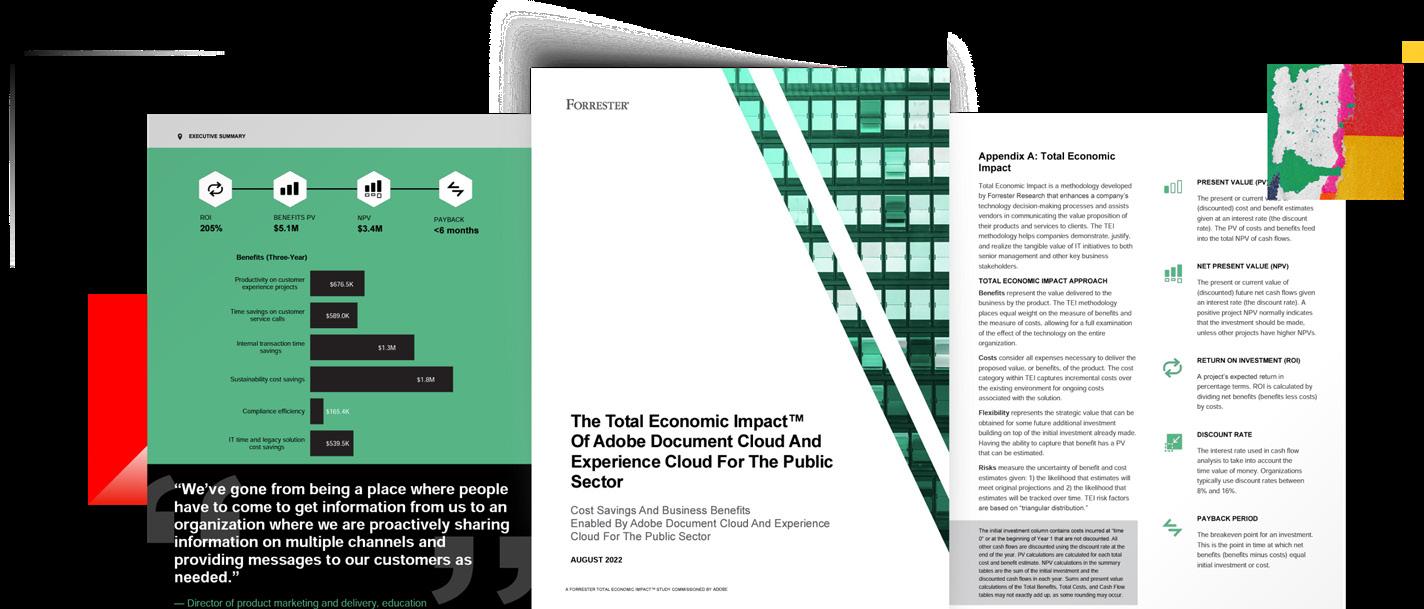
Business Information for Local and Central Government www.governmentbusiness.co.uk | ISSUE 30.3 ROAD MAINTENANCE DESIGN & BUILD WASTE MANAGEMENT HEALTH & SAFETY INSIDE NEW LOOK DESIGN PLUS: FIRE SAFETY | LEVELLING UP | DIGITAL | GROUNDS CARE Web traffic is up. Phone calls are down. Learn how Adobe can drive 205% ROI for government agencies. What is the best way to go about tackling the problem? JAPANESE KNOTWEED & LOCAL AUTHORITIES INVASIVE PLANTS





Issue 30.3 | GOVERNMENT BUSINESS MAGAZINE 2 Conferences Meetings Exhibitions Outdoor Events Banquets Team Building Live Events Christmas Parties Book your next event with us. THEJOCKEYCLUB.CO.UK/VENUES ENQUIRIES@JOCKEYCLUBVENUES.CO.UK Choose from one of our 15 Racecourses across the country. UNIQUE SPACES WORLD-CLASS VENUES

Comment PUBLISHED BY PUBLIC SECTOR INFORMATION LIMITED 226 High Rd, Loughton, Essex IG10 1ET. Tel: 020 8532 0055 Web: www.psi-media.co.uk Business Information for Local and Central Government EDITOR Polly Jones PRODUCTION MANAGER & DESIGNER Dan Kanolik PRODUCTION DESIGNER Jo Golding PRODUCTION CONTROL Deimante Gecionyte ADMINISTRATION Enkelejda Lleshaj WEB PRODUCTION Freya Courtney ADVERTISEMENT SALES Clive Beer, Simon Connor, Steve Day, Karl Hynes, Azad Miah, Bernie Miller PUBLISHER Kylie Glover GROUP PUBLISHER Karen Hopps To register for your FREE Digital Subscription of Government Business magazine, go to www.governmentbusiness.co.uk/digital-subscription or contact Public Sector Information, 226 High Road, Loughton, Essex IG10 1ET. Tel: 020 8532 0055 www.governmentbusiness.co.uk P ONLINE P MOBILE P FACE-TO-FACE Business Information for Local and Central Government Welcome to E Editor’s Comment Government Business 30.3 Issue 30.3 | GOVERNMENT BUSINESS MAGAZINE 3






CLICK HERE TO CONTACT US NOW BY EMAIL SAVE TIME AND MONEY WHILST GAINING GREATER EFFICIENCIES AND SECURITY. SUITABLE FOR HOSPITALS, CLINICS AND SURGERIES ONE KEY FOR ALL YOUR LOCKS DOORS | CABINETS | SENSITIVE EQUIPMENT | IT FACILITIES | MOBILE ASSETS www.sellox.co.uk www.cyberlock.com



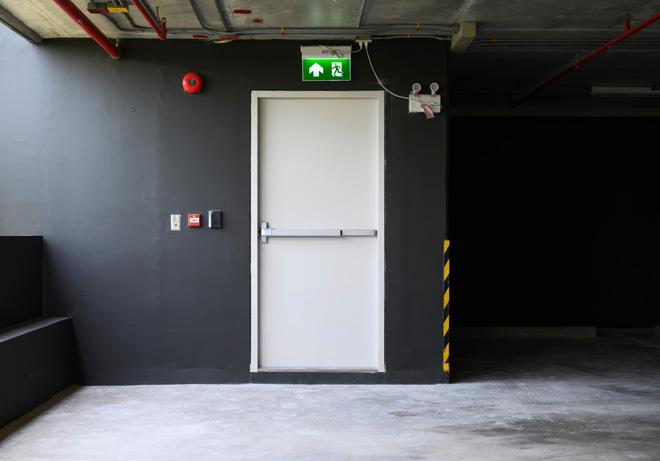












Contents Government Business 30.3 Contents HOUSING 2023 HEALTH & SAFETY FIRE SAFETY LEVELLING UP DIGITAL CYBER SECURITY FRAMEWORKS ROAD MAINTENANCE WASTE MANAGEMENT G-CLOUD CONFERENCE & EVENTS FRAMEWORKS GROUNDS CARE INVASIVE PLANTS 12 17 23 30 49 36 41 55 61 64 77 83 87 93 67 FRAMEWORKS Government Business magazine www.governmentbusiness.co.uk Issue 30.3 | GOVERNMENT BUSINESS MAGAZINE 5







Brilliance 7000 27” (68.6 cm) | Mini LED | Thunderbolt 4 | 4K UHD 27B1U7903/00 MINI LED Local Dimming MiniLED with Thunderbolt docking Simply brilliant Monitors
ELECTIONS
Big losses for Conservatives at local elections
The Conservatives suffered big losses at the recent local elections, losing more than 1,000 seats and 40 councils. Meanwhile, Labour, the Liberal Democrats and Greens have picked up more seats, with Labour gaining 500 seats.
The Conservatives lost majorities in Tamworth, Brentwood, Hertsmere and North West Leicestershire, while Labour won Plymouth, Medway and Stoke-on-Trent. Windsor and Maidenhead were won by the Lib Dems.
The Liberal Democrats won 12 councils, including Windsor and Maidenhead and Stratford-on-Avon from the Conservatives. The Greens also won in Mid Suffolk, the first time they have won a council.
Labour’s Chris Cooke has become mayor of Middlesbrough, beating the Independent incumbent by just 760 votes.
8,000 seats on 230 councils were up for election, as well as four mayoral posts.

Homes England launches fiveyear Strategic Plan

Homes England has launched its next five-year Strategic Plan to deliver quality, affordable homes and regenerate towns and cities.

The plan by the Government’s housing and regeneration agency sets out how it will support communities and families by enabling the delivery of more good quality, affordable homes alongside the regeneration of towns and cities across England.
The plan is supported by £16 billion of Government funding, with sustainability, decency and good design as a focus. The plan sets out how the Agency can work with its partners and deliver a revitalised built environment across England that serves the needs of all communities.
The plan also commits Homes England to working in a more place-based way, tailoring its powers, funding, expertise and technical capacity to the specific challenges faced in different parts of the England.
Chair of Homes England, Peter Freeman said: “This is a pivotal moment for Homes England as we reaffirm our role as the Government’s housing and regeneration agency and go even further in helping to create the thriving places of the future.”

Rachel Maclean, minister for housing, said: “Creating high-quality and sustainable homes that people can be proud of is an absolute priority for this Government. We continue to work with partners and developers to facilitate a brownfield-first approach to meet local housing needs for local people.”

HOUSING CONTINUE READING READ MORE News Issue 30.3 | GOVERNMENT BUSINESS MAGAZINE 7





Government announces funding to improve walking and cycling routes
The government has announced £200 million to improve walking and cycling routes around the country.
The newly funded schemes are expected to generate up to 16 million more walking and cycling trips a year across the country.
The funding is intended to enhance rural connections, create 120 miles of cycling track and see 130 more schemes to help over 35,000 children on their way to school. The improved routes will boost healthier travel options and grow the economy.

265 schemes in 60 areas will receive a share of the funding.
Transport secretary Mark Harper said: “We want to make sure everyone across the country can choose cheaper, greener and healthier travel while we continue to support our local businesses and grow the economy.
“This £200 million investment will improve road safety, ease congestion and ultimately improve the health and wellbeing of the millions of people choosing active travel.”
National active travel commissioner Chris Boardman added: “By giving millions of people the freedom of choice to walk, wheel or cycle for everyday trips, this funding will help us improve public health, tackle climate change and give hundreds of thousands of children the independence to travel safely under their own steam.
“Now our focus is working with councils to get these schemes built swiftly. We’ll be working together to ensure the projects are well-designed and effective, so that they bring maximum benefits to communities and help improve lives nationwide.”
Funding announced to transform local skills
The government has announced £165 million of funding to transform local skills.

The funding is intended to address local employer skills gaps, transform training and grown the economy.
Further education providers are being invited to apply for funding from the Local Skills Improvement Fund. The money will be used to to renovate facilities with up-to-date equipment, help to upskill teachers, and deliver new courses in key subjects such as green construction, carbon capture and cyber security that meet the needs of local employers.
It is hoped that thousands of people will benefit from skills training and help them secure jobs close to where they live. This should then boost the local economy.
Minister for skills, apprenticeships and higher education Robert Halfon said: “Building a world-class skills and apprenticeships nation means listening to the specific needs of local people, businesses, and institutions.

“This funding will revolutionise how we plug local skills gaps and provide a boost to the economy. Supporting colleges to better meet the needs of local employers not only boosts businesses, it extends the ladder of opportunity to even more people from all backgrounds who will be equipped with the skills they need to secure a rewarding job close to home.”
Jamie Stevenson, group executive director at New City College, which was a recipient of funding said: “Being the project lead for the Central London Forward SDF project has enabled us, alongside local employers and stakeholders, to pioneer a new way...


ACTIVE TRAVEL
LEVELLING UP CONTINUE READING CONTINUE READING News Issue 30.3 | GOVERNMENT BUSINESS MAGAZINE 9

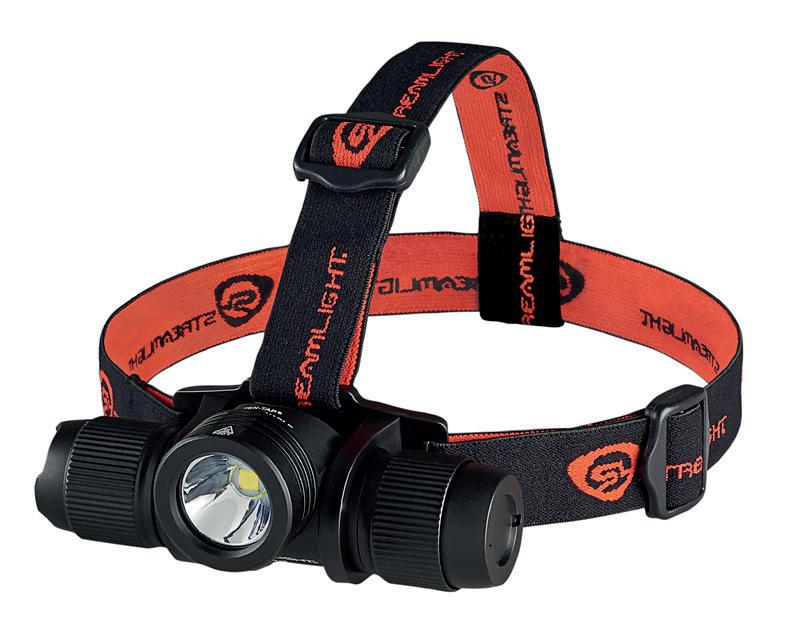



Issue 30.3 | GOVERNMENT BUSINESS MAGAZINE THE NEW PROTAC ® 2.0 SERIES USB RECHARGEABLE, FEATURING 2,000 LUMENS WITH NO REDUCTION IN RUN TIME HANDS FREE PROTAC ® 2.0 HEADLAMP WEAPON MOUNT PROTAC ® 2.0 RAIL MOUNT LONG GUN LIGHT HANDHELD PROTAC ® 2.0 TACTICAL FLASHLIGHT Made for situations when failure is not worth contemplating, Streamlight® has created the broadest range of professional torches and lighting tools that can be trusted for a lifetime. streamlight.com POWRED BY THE NEW SL-B50 ® USB-C RECHARGABLE LITHIUM-ION BATTERY PACK
TfL project to unlock public land for EV charging

Transport for London (TfL) has awarded Zest a contract to provide and operate 39 rapid or ultrarapid electric vehicle charging bays on public land, such as those owned by local authorities and the NHS.
The charging points will be in installed 24 locations in south and southwest London by the end of 2024 including outer London boroughs such as Sutton and Bromley.
The charging infrastructure will be placed in parking bays near key routes used for essential road journeys typically made by high mileage, commercial users - including taxis and freight.
Part of TfL’s EV Infrastructure Delivery Programme, these new EV charging bays further expand London’s charging network. The Mayor is fulfilling his pledge to unlock land owned by TfL and other members of the Greater London Authority, including the London Fire Brigade, the London Ambulance Service, and the Metropolitan Police, as well partners in the NHS, to increase the density of the rapid charging network across the city. This innovation sees TfL take public land to the private market to help bring the infrastructure needed to keep London at the forefront of the electric vehicle revolution.
David Rowe, TfL’s Director of Investment Delivery Planning, said: “These 39 bays are the start of our new programme to boost the number of rapid charging points in the capital by making public land available to private sector providers to support those making the switch to zero emission vehicles. More rapid charging points are key to encouraging people and businesses to make the transition to electric vehicles, giving drivers...
Funding announced for grass-root sports facilities: READ MORE
North Tyneside Council reuses EV batteries to help power electric fleet: READ MORE
National Highways outlines measures to improve strategic road network: READ MORE Bus fare cap extended: READ MORE
Further funding announced for free school meals in Wales: READ MORE
£1.7 million for museums and libraries in Wales: READ MORE
RECRUITMENT
Quarterly Recruitment Outlook: No sign of hiring difficulties easing
Attempted recruitment in Q1 was virtually unchanged from the previous quarter, with 59 per cent of those surveyed looking to find staff (61 per cent in Q4 2022).
While recruitment difficulties are being experienced across the economy, firms in the hospitality and manufacturing sectors were the most likely to report recruitment difficulties (83 per cent in each sector). This is closely followed by the construction and engineering sector (81 per cent) and then professional services; and public, education, health sector on 79 per cent. The recruitment pressure points vary across sectors. For firms who struggled to recruit in the construction and engineering sector, 71 per cent faced difficulties in finding skilled manual/ technical workers. However, for hospitality businesses that struggled to recruit, 64 per cent faced difficulties in finding semi/unskilled workers.
Investment in training remains stubbornly low in an environment of increasing cost pressures. Just over a quarter of firms (27 per cent) reported an increase in their training investment plans over the last three months (24 per cent Q4 2022), while 14 per cent report a drop.
Overall, 67% of businesses say labour costs are a source of inflationary pressure, with...



EV CHARGING CONTINUE READING
top news stories
More
from www.governmentbusiness.co.uk
CONTINUE READING News Issue 30.3 | GOVERNMENT BUSINESS MAGAZINE 11
Housing 2023: 27-29 June, Manchester Central
3 days | 8300+ attendees | 450+ speakers | 10 streams of content | 350+ sponsors and exhibitors | 60 official fringe events
Throughout the whole of the UK, the housing sector is facing unprecedented challenges. This includes uncertainty in government funding; new regulations; the pressing need for more homes; the equally pressing need to maintain and improve the homes we have while modernising procedures and services to meet the expectations and needs of tenants and residents. And that’s without mentioning external pressures such as the continuing cost-of-living crisis and the pressure on all other public sector services.

That’s why, for Housing 2023, we have put together a fantastic programme of content that packs in lots of learning. With an abundance of thought-leaders and expert-thinkers joining us across three days, the event is an opportunity to come together with peers from across the sector to network and innovate. And through all of this,

12
Housing 2023
Network with over 8,000 housing professionals and find the whole supply chain under one roof
we’ll make sure improving professionalism is at the heart of every discussion, to ensure you continue to provide the best outcomes for your tenants and residents.
Why attend Housing 2023

Learn something with 150+ hours of CPDaccredited sessions across six stages on the show floor – the award-winning Fringe stage, Unlock Net Zero Live stage, Tenant and Resident Engagement stage, Knowledge and Insight stages and PfH Live. Engage with government at Housing 2023 and hear essential updates and guidance from leaders across housing including DESNZ, DLUHC, Homes England and RSH. Hear from over 450 speakers covering topics including net zero challenge, the cost-ofliving crisis, building safety, affordability,
funding, housing delivery, tenant engagement, specialist housing, data, mental health and wellbeing, innovation and much more. Plus, network with over 8,000 housing professionals and find the whole supply chain

Issue 30.3 | GOVERNMENT BUSINESS MAGAZINE 13
E
Housing 2023
F under one roof, from the main procurement frameworks to government bodies, from development and asset management experts to green home suppliers and engagement specialists, Housing covers the entire supply chain! Discover a show floor packed with 350+ exhibitors and discover new and innovative solutions that could help you deliver better quality homes.
The Housing experience
Housing is not just about the award-winning content, it is an opportunity to meet, share, collaborate and take the opportunities on offer back to your teams and organisations. This year, there are more tangible outcomes and takeaways than ever before, and a programme of events and activities for you and your teams to take part in:
Celebrating Brunswick – an anniversary tour (26 June) – join our study tour to see the Brunswick Village development showcasing great community spirit, regeneration and extra-care living.

Women in Housing/Housing Heroes Awards (26 June) – the opening ceremony at Housing 2023. Celebrate the leaders, innovators and changemakers across the sector, shining a light on the incredible work carried out by teams and individuals in the past 12 months.

Housing 2023 14
The housing jobs fair will bring together the largest recruiters in the region and those looking for opportunities to join a longterm career in a sector that supports local communities
Attend the Unlock Net Zero Live Awards (27 June) recognising and championing progress on the journey to decarbonisation for the UK housing sector and the supply chain that supports it.

Take part in our charity walk to Castlefield Viaduct (28 June), the National Trust’s Manchester garden in the sky. This is one not to be missed and a great chance to keep fit whilst giving back.
Housing Rocks, charity fundraiser (28 June) – join up to 900 people who want to give back at Housing Rocks and raise as much for charity as possible. Submit ‘bands’ for rocka-oke followed by a true Mancunian DJ!
Housing jobs fair (29 June) in partnership with GMCA Careers Hub, GM Housing Providers, Manchester City Council, Manchester Evening News, Inside Housing and supported by Cllr Bev Craig, leader, Manchester City Council. For all those looking for a career with purpose. The housing jobs fair will bring together the largest recruiters in the region and those looking for opportunities to join a long-term career in a sector that supports local communities.
Housing is the biggest event in the housing calendar and absolutely the place for you and your teams to be. This year, there are more tangible outcomes and takeaways than ever before.
Housing has something for everyone! #bettertogether #ukhousing.

Register for your free* visitor pass now: housingevent.com or use the link below. L
*Visitor passes are free to housing associations, local authorities, public sector, housebuilders, master developers, funders, architects, planners and BTR landlords, student accommodation, retirement living and extra-care providers. Fees will apply to other commercial organisations and will be automatically added so please ensure you register using your work email address. https://eventdata.uk

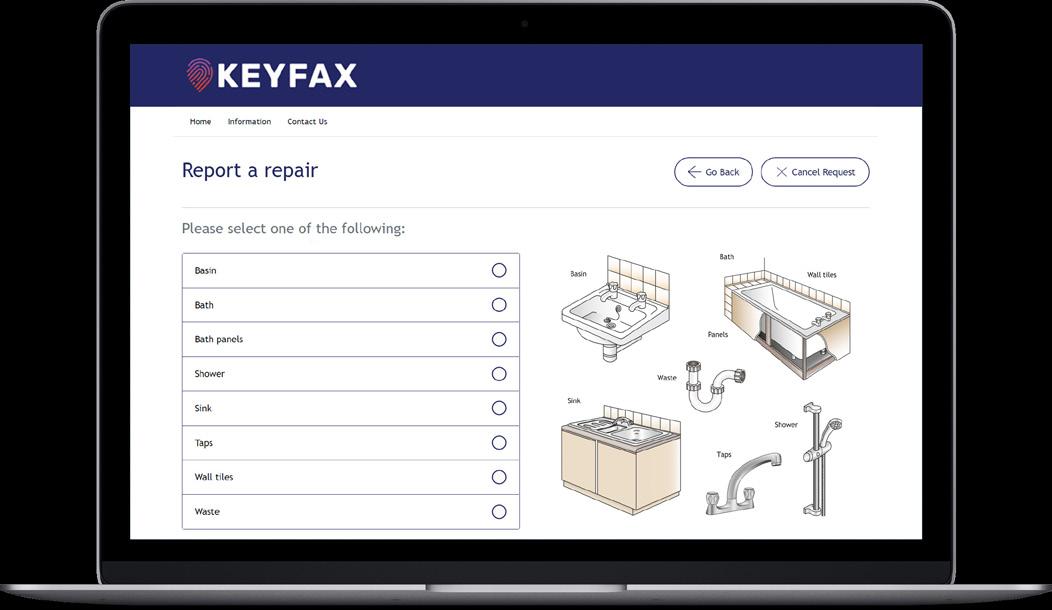
FURTHER INFORMATION Providing software and services to the housing sector Improve Customer Satisfaction Optimise Service Processes Increase First Contact Resolution info@omfax.co.uk www.omfax.co.uk
Issue 30.3 | GOVERNMENT BUSINESS MAGAZINE 15









We’re the experts, so you don’t have to be www.projecthss.com 0141 471 6266 info@projecthss.co.uk Supportive Reliable Trustworthy Project Health and Safety Services – we’re the experts, so you don’t have to be. Project Health and Safety Services is a well established and trusted Health and Safety Consultancy and Training Provider based in Glasgow, operating across the UK, with experience across a variety of industries and sectors, including the public sector. Whether you are looking for one-off health and safety advice, assistance with a project, or to transform the health and safety culture of your organisation then get in touch to see
our experienced health and safety advisors can help. • Technology-Led solutions for Health and Safety • Health and Safety Consultancy • CITB and IOSH Certified Training Courses • Accredited eLearning Training • Health and Safety Management Systems • Executive Coaching • Health and Safety GAP Analyses and Audits • Workplace Safety Inspections • Cultural and Behavioural Safety Programmes • Accident and Incident Investigations • CDM (2015) Advice and Support • Interim Safety Department
how
Slips and trips
Saeed Ahmadi, of the Institution of Occupational Safety and Health (IOSH), examines the issue of slips, trips and falls and how organisations can prevent them from happening

Slips, trips and falls are a common cause of workplace accidents and injuries all over the world. Based on an International Labour Organisation (ILO) survey, they cause over a third of all major injuries in workplaces and can lead to other types of accidents, such as falls from height or falls into other hazardous conditions. The same survey also highlighted that slips and trips account for half of all reported injuries to members of the public in workplaces where there is public access. This includes hospitals, shops, and restaurants. The UK itself is no different. Statistics published in the UK by the Health and Safety Executive showed that in 2021-22, slips, trips and falls accounted for 30 per cent of accidents which caused injuries in workplaces. This is in comparison with handling, lifting and carrying (18 per cent), being struck by a moving object (11 per cent), acts of violence (nine per cent) and falls from height (eight per cent). Why is this happening? In busy environments with lots of foot traffic, flooring problems can quickly develop into dangerous hazards. From spillages to uneven wear of the floor or the ground surface, it’s crucial that those in control of workplaces and public places take E

Health & Safety Issue 30.3 | GOVERNMENT BUSINESS MAGAZINE 17
Aplus Safety and Training Services
Limited provides both in-house and on-site high quality training. All courses are delivered in a relaxed structured environment covering all aspects of health, safety and environmental matters.
As an approved NEBOSH, IOSH, CITB, Qualsafe and NPORS course provider, we are proud to support our clients in achieving their health, safety and environmental training needs.


HEALTH & SAFETY COURSES | FIRST AID COURSES

FIRE COURSES | CONSTRUCTION COURSES


BESPOKE COURSES
For full portfolio visit www.aplussafetytraining.co.uk or call 01793 827314

18 BUSINESS INFORMATION FOR LOCAL AND CENTRAL GOVERNMENT | www.governmentbusiness.co.uk Appr ed training provider 1031 631 Accredited Centre 5308
F proactive steps to prevent and deal with these issues before they cause a serious problem.
In almost all slip and trip incidents, contamination is involved in some form. For example, obstructions on walkways or uneven surfaces usually cause trips. Slips and trips can both result in a fall that occurs at the same level, as well as a fall from height in some circumstances.
But, as with other health and safety risks, it doesn’t have to be this way. Measures to prevent slips and trips are often simple and cost-effective for organisations – and much preferable to an incident actually happening and the personal and organisational fallout that happens as a consequence.
The place to start is by undertaking a risk assessment to identify hazards – this is an effective preventative strategy as you can’t manage the hazards if you don’t know what they are.
Hazard Identification
Slips happen when someone is moving, when there is a loss of friction between the moving person and the surface being walked on. Such a loss of friction can lead to a loss of balance, unintended impact with other surfaces and/or a fall at the same level. In some circumstances, slips can lead to a fall from height. For example, a slip on an icy walkway, at the top of staircase, could lead to falling down the staircase.
Most slip and fall accidents are caused by contamination. Examples of this include rainwater, oil or dust being on the floor. And it doesn’t take a lot to create an issue. Even a small amount of contamination can be a slip hazard on smooth surfaces like vinyl, ceramic tiles or varnished wood floors.

Trips happen when the foot or lower limb gets caught on, collides with, or strikes something. Like slips, trips lead to a loss of balance, unintended impact with other surfaces and/or a fall at the same level, as well as possibly falls from height.
They can be caused by many things, but some of the common ones include: poor housekeeping, uneven surfaces, a
change in floor surface or level, damaged or worn-out carpets, raised slabs or drain covers, cracks or holes in a surface, and poor lighting, or insufficient lighting in work areas (internal or external).
When looking to identify possible trip hazards, an effective way is to give consideration of the trip potential triangle [pictured above], as detailed by the Health and Safety Executive. This is an effective and straightforward approach to identifying any potential hazards.
How to assess the risk of slips and trips
Once an organisation has identified slip and trip hazards, their risk assessment should be used to evaluate the risks. Slips and trips can be assessed using different risk assessment methodologies depending on the type of activities or work processes and equipment. Typically, workplaces will use a task-based approach after identifying hazards.
Applying control measures based on hierarchy of control
Having identified the risks, we then use the hierarchy of control (HOC). This describes a method of controlling risks that have E
Health & Safety
Trip Potential Triangle Issue 30.3 | GOVERNMENT BUSINESS MAGAZINE 19
Walkways Housekeeping Design & maintenance
Road Transport Expo takes place at NAEC Stoneleigh from 28-30 June 2023. See the latest trucks, tippers, skip loaders, RCVs, sweepers, utility vehicles, bodybuilders, tyres, safety equipment and more. Plus experience live displays, ‘ride and drives’ and informative seminars.

The one-stop industry event that’s all about the truck and everything related to it IN ASSOCIATION WITH

REGISTER NOW
Register for your FREE tickets at roadtransportexpo.co.uk See the BIG SEVEN at Road Transport Expo 2023
F been identified within an organisation. In order, the elements of the HOC to reduce the likelihood of slip and trips incidents are:
1. Elimination – physically remove slips or trip hazards: removing sources of floor contamination.

2. Substitution – replacing the hazard with something safer: usage of non-slippery flooring materials, avoiding using loose rugs or mats, and dry sweeping instead of wet seeping.

3. Engineering controls – redesign or introduce engineering controls: cleaning equipment, drainage, improving visibility/ lighting, posting a warning sign or barricading the area, providing handrails and nonslip edges on steps, and adding reflective edges on stairs to improve visibility.
4. Administrative controls – setting policies, plan, and procedures: policies such as housekeeping (regular cleaning, mopping, sweeping debris), daily housekeeping checks (floor inspections, checks for damage), and signage.

5. Personal protective equipment (PPE) – footwear provision: safety shoes or boots, and slips-resistant footwear.
To conclude, although slips, trips, and falls can be considered a common hazard almost everywhere, the risk can be effectively managed through simple considerations. The immediate removal of surface contaminations, proper housekeeping, ensuring sufficient visibility, good sign posting, and isolation of high-risk locations are some lowcost effective measures for elimination or minimisation of slips, trips and fall hazard.
The Health and Safety Executive provide examples on their website of good risk management to prevent slips and trips. One of these is for Livingston NHS Trust, where it says: “Livingston NHS Trust were having problems at their main entrance on wet days. They extended the entrance area by three metres to provide a large external canopy and installed a three-stage matting system. Different grades of
matting were installed on the outside, transition and indoor areas. The first layer takes water to drain, the second layer takes water and dirt and the third layer is an absorbent layer which removes water and dirt. The new entrance ‘system’ is proving to be very effective at removing water and other contaminants from pedestrian footwear on wet days. A system is in place to deal with local contamination and is coned off immediately. Over a number of years only a few falls were recorded in the area.”
With this and other examples, the message is clear: you don’t have to spend a huge amount of money to manage the risks – failure to do so can be much more costly. L
Health & Safety
You don’t have to spend a huge amount of money to manage the risks
21
Fuelling innovation to overcome obstacles
Managers working in the public sector face tough daily challenges driven by budget limitations, rising service demands, workforce issues, and rapid technological progress. Tackling these obstacles demands innovative thinking, collaboration, and effective resource management to continue delivering essential services to the communities they serve
Utilise the GROW coaching model: The GROW coaching model (Goal, Reality, Options, and Way Forward) is a valuable framework that managers can use to help their team members clarify their goals, assess the current situation, explore different options, and identify action steps. With this approach, managers can empower their teams to come up with their own solutions to overcome obstacles and daily challenges.
Here are five ways managers can fuel innovative thinking in their teams:
Create a supportive environment for idea sharing:
Cultivate an environment where team members feel comfortable sharing their ideas and suggestions without fear of judgment. Encourage open dialogue and value every person’s input, regardless of their position or seniority. This approach builds trust and “psychological safety,” two crucial ingredients that help team members feel confident that their input will be valued.
Encourage cross-functional collaboration:
Managers can organise workshops and brainstorming sessions that bring together people from different departments with diverse skill sets, backgrounds, and experiences. This approach encourages collaboration and can trigger fresh perspectives and new ideas that might not have emerged within a single team or department.
Integrate fun and interactive tools: To stimulate creative thinking and fresh ideas in team meetings, managers can incorporate tools like the brainsparker app, which uses random prompt cards to trigger fresh thinking and brainstorm new ideas. Other tools like whiteboards, sticky notes, and mind maps can help team members visualise and organise their ideas. This approach enhances engagement and develops valuable creative problem-solving skills.
Reward innovative ideas:
Acknowledging and rewarding innovative ideas, even if they don’t lead to immediate success, is essential to motivating team members to think creatively. This reward system can take various forms, from monetary incentives and promotions to public recognition or additional opportunities for personal and professional growth. By fuelling innovation, managers can ensure their teams are equipped for the challenges of today and deliver better solutions to the communities they serve. L
Gabriella Goddard is the Founder of Brainsparker App.


22 BUSINESS INFORMATION FOR LOCAL AND CENTRAL GOVERNMENT | www.governmentbusiness.co.uk
FURTHER INFORMATION brainsparker.com Adveretisement Feature
The life-saving role of fire doors in public sector buildings
Helen Hewitt, CEO of the British Woodworking Federation (BWF) explains best practice for fire doors in public buildings
Day to day, a fire door is used in the same the way as for any other door. However, in the event of a fire, the fire door must then perform its primary role – to protect lives and prevent the spread of fire and/or smoke.
So, what part do fire doors play in ensuring a building’s safety? Who is responsible for them, and what measures need to be taken to ensure they perform as intended in the event of a fire?
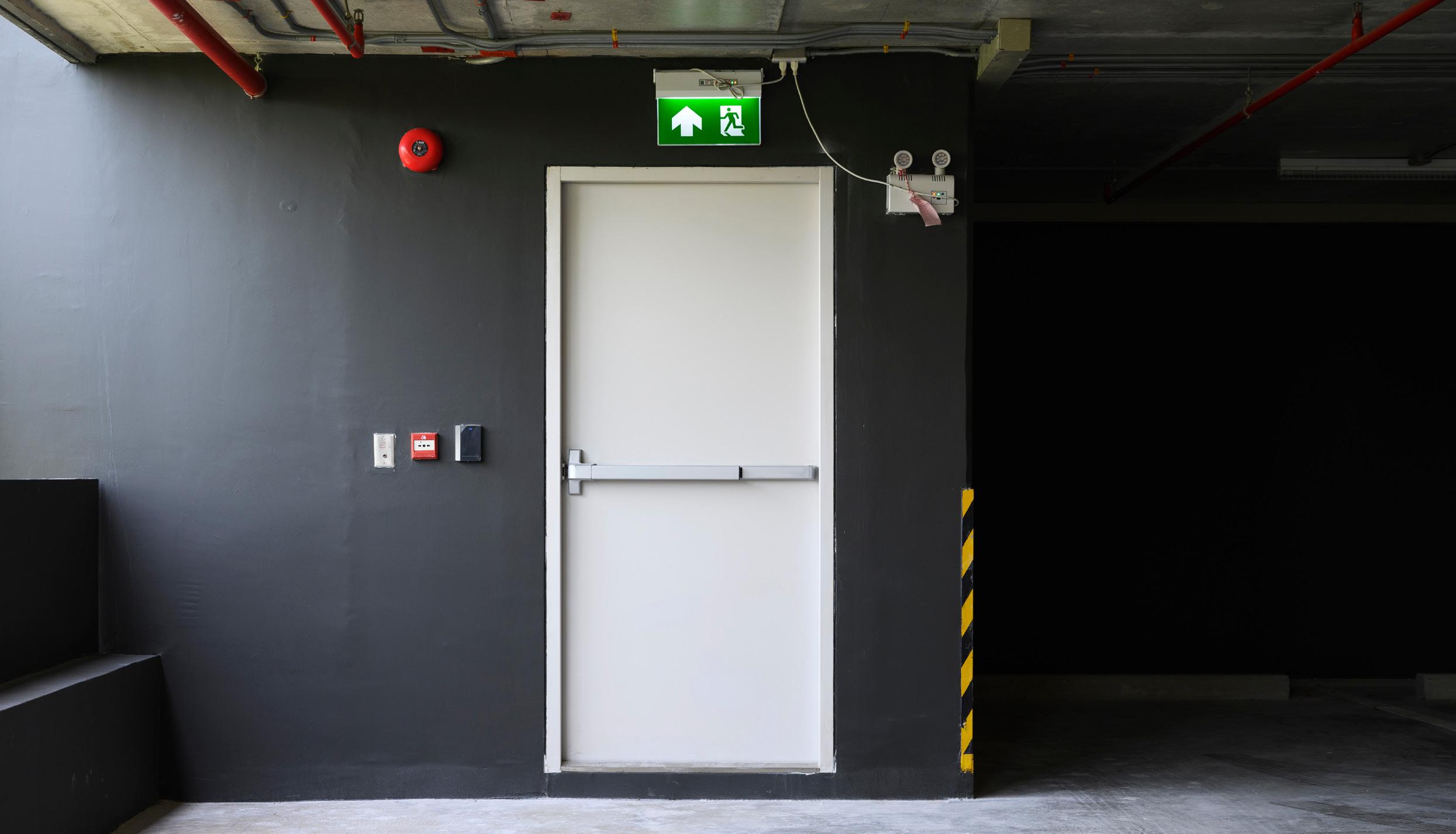
What role do fire doors have in public buildings?
Fire doors are required in most public, commercial and multiple occupancy buildings and they form a crucial part of a building’s
passive fire protection strategy. Fire doors help hold back the spread of fire and/or smoke to allow for a safe means of escape for building occupants while enabling the emergency services to enter the building.
They consist of specialist components which have been designed and tested to control the passage of smoke and withstand fire for a defined period. They enable access between the compartments of a building that are used to contain a fire while preventing a fire spreading from one area to another, and are used to maintain vital escape routes.
In public sector buildings such as care homes or houses of multiple occupancy, which often E
Fire Safety Issue 30.3 | GOVERNMENT BUSINESS MAGAZINE 23
F house vulnerable people, a safe route of escape is essential. In the case of healthcare buildings, protecting escape routes for as long as possible can be vital where the occupants of the building may have difficulty responding to a fire alarm or escaping from the building unaided.

The importance of fire door classifications

For escaping a building, the fire door classification – the period for which a fire door can resist fire, and whether the fire door is also a smoke control door – is vital. Fire doors can be classified under the National System or the European System. A fire door assembly that has been tested to BS 476: Part 22 for fire resistance and was found to resist fire for a minimum of 30 minutes can be classified under the National
System as FD30. After further testing to BS 476-31.1 for smoke control, a fire door can be classified as FD30S.
Alternatively, a fire door can be tested for fire resistance to BS EN 1634-1 and if it resists fire for a minimum of 30 minutes, it can be classified under the European System as E30. If the door is also tested for smoke control to BS EN 1634-3 it can be classified as E30Sa.
Who is responsible for fire doors in public buildings?
The Regulatory Reform (Fire Safety) Order 2005 (FSO) states that every public building must have a ‘Responsible Person’, typically the building owner or a facilities manager. In addition to carrying out fire risk assessments, the Responsible Person must also take steps to reduce or remove any fire safety risks on an ongoing basis and ensure inspections of fire safety ‘assets’, such as fire doors, are carried out regularly.
How often should fire doors be inspected?
Public sector buildings such as hospitals, care homes and schools often have high levels of through-traffic, making fire doors vulnerable E
Fire Safety
Issue 30.3 | GOVERNMENT BUSINESS MAGAZINE 25
For escaping a building, the fire door classification – the period for which a fire door can resist fire, and whether the fire door is also a smoke control door – is vital




26 BUSINESS INFORMATION FOR LOCAL AND CENTRAL GOVERNMENT | www.governmentbusiness.co.uk DOWNLOAD HERE 500K+ downloads 1 2K r ti (UK) Visit: www brainsparkerapp com Email: hello@brainsparker.com Call: 0207-096-1469 Unlock Innovation in the Public Sector √ CREATIVE BRAINSTORMING TOOL √ BOOST PROBLEM-SOLVING SKILLS √ GENERATE BREAKTHROUGH IDEAS √ UPSKILL WITH BITE-SIZED TRAINING
Frequency of inspection depends on many factors, including the age and condition of the door
F to inevitable wear and tear. This is particularly true for healthcare settings where fire doors can also be damaged by the transportation of beds and trolleys.
Cracks and dents in a door – and any gaps between the door and its frame – will not only reduce its effectiveness and ability to perform as designed in the event of a fire, but can also harbour bacteria, impacting vital hygiene standards.
Frequency of inspection depends on many factors, including the age and condition of the door. For example, the Fire Safety (England) Regulations 2022 requires that, for buildings that contain two or more domestic premises and are over 11 metres in height, the Responsible Person, “must use best endeavours to undertake checks of fire doors at the entrances of individual domestic premises in the building at least every 12 months,” and they, “must undertake checks of any fire doors in communal areas of the building at least every 3 months.” In addition, BS 999:2017 Fire Safety in the design management and use of buildings –code of practice, Annex I, contains guidance on the “routine inspection and maintenance of fire safety installation” for the daily, monthly and six-monthly checks on fire doors.
However, in buildings where fire doors are in high use and therefore more susceptible to damage, for example in hospitals and schools, best practice recommends that they are inspected as frequently as each week or each month based on the door’s usage. Visual inspections of fire doors can help quickly identify any obvious maintenance issues that need to be addressed. However, the role of fire door inspectors should not be overlooked. Qualified and experienced fire door inspectors can conduct a thorough inspection and highlight issues that may not be easily visible but that could prevent the door performing as intended in the event of a fire. However, everyone can play a role in maintaining the fire safety of the buildings they occupy - the BWF’s Five Step Fire Door Check highlights the key elements to look for when you suspect a fire door may be in need of maintenance. Also, the Government has developed a checklist to support the Responsible Person with their fire door checks.
Why is third-party certification important?
Knowing that a fire door will perform as stated in the event of a fire is crucial. A standalone fire test report can evidence the performance of a fire door, but it can only cover the actual E

Fire Safety
Issue 30.3 | GOVERNMENT BUSINESS MAGAZINE 27
Fire
F configuration of the fire door assembly that was tested and there is no oversight of the production of doors produced following the one-off test.
Fire door third-party certification is a robust process which involves the fire door manufacturer or processor being audited by an independent third party to provide evidence that the fire door is appropriately tested and produced to a consistent standard.
For members of the BWF Fire Door Alliance, this involves meeting the strict criteria of an initial programme of fire testing, and auditing of the manufacturing process and quality management systems, which are confirmed by ongoing, regular, product testing and auditing.
This provides vital evidence of performance and ensures that the initial tests were not a one-off result, giving building owners, the Responsible Person, specifiers and building users peace of mind that the fire door will perform as designed in the event of a fire. It also offers traceability throughout the construction supply chain, allowing access to important information about the door’s component parts which is essential to maintaining the door’s certification should any components or maintenance be needed.
When a fire door is manufactured or modified by a member of the BWF Fire Door Alliance, an identifying label or plug is applied to the door in accordance with the chosen certification scheme. This allows for full traceability of the door by the fire door manufacturer or licensed processor, enabling access to documentation related to its specification and production records. This means the original fire certificate and specification can be sourced, enabling
on-site checks to be carried out against the door’s original standards. If it’s found that any components should be replaced, the documents will also outline the parts compatible with the original certification and test requirements to ensure compliance is maintained.

Best practice and advice
To support the Responsible Person and all building owners in meeting their obligations, the BWF and the BWF Fire Door Alliance has produced a range of advice and e-learning materials covering fire door responsibilities and key knowledge, as well as best practice for inspections and maintenance. L
FURTHER INFORMATION
https://firedoors.bwf.org.uk/knowledgecentre/fire-door-inspection-maintenance
Safety
Fire door third-party certification is a robust process
28
Taking the smart LED: The benefits of well-connected lighting in workspaces
Ever wonder why we feel more awake at home, just when we should be winding down to sleep and feeling the opposite at work? Well, there’s more science to this than an unpleasant work environment. Cedric Collard, business segment manager at Schréder, talks about the health benefits of switching to LED lights and its aid in boosting productivity
In an ideal world, we’d all be exposed to an abundance of natural light, but of course the vast majority of us spend our working day indoors. And that’s when LED lighting systems come into their own.
Enhancing the work environment for students and staff
Research shows that spending most of our days in a well-lit environment can boost performance and help us enjoy deeper, more satisfying sleep. Whereas, if we’re exposed to dim light by day and bright light by night, it eventually erodes the quality and quantity of our sleep, which in turn can impact our mood, stress levels and in due course, even our physical health.
Well-designed lighting systems can be adjusted in both intensity and colour throughout the day, owing to the rapid development of smart technologies. Students can benefit from exposure to these lights because they work in harmony with our body clocks, to reach optimum energy and boost performance, whilst reducing fatigue and sharpening focus.
Productivity and Savings: The Schréder Experience
With energy prices relentlessly rising, there has never been a better time for businesses and local authorities to reduce overhead costs and increase productivity. Money is often wasted on poorly designed systems that don’t benefit the health of your staff or your finances, and what people don’t know is that installing the optimal lighting solution for each area also offers significant financial savings too.
Remote control of each luminaire is possible through our CMS (Control Management System), Schréder’s EXEDRA, which allows you to monitor, meter and manage a lighting network.
As a result, this improves efficiency: accurate real-time data and energy savings of up to 85 per cent. In areas that are not frequently used –such as storage zones – sensors can ensure that the lights are only activated when movement is detected. This means energy and money aren’t wasted illuminating areas where no light is needed. Schréder’s lighting systems also require less maintenance than traditional discharge lamps, which means another reduction in costs.
Area of expertise
Whether it’s a classroom, corridor, sports field, or carparks, Schréder’s dedicated systems offer solutions to suit YOUR space. Our expertise enables any workplace or industrial environment to be transformed into a safe, sustainable, and cost-effective workplace, where your employees and students can enjoy the best possible working conditions. L FURTHER INFORMATION
Get in touch lightingsurvey@urbis-schreder.com, to book your free survey and talk to us about your current installations.

Advertisement Feature
Issue 30.3 | GOVERNMENT BUSINESS MAGAZINE 29
The Increase VS Programme: key lessons for levelling up deprived communities

New research led by the University of East Anglia (UEA) shows that large infrastructure projects which are the focus of the UK government’s levelling up agenda and include support for business start-ups, must also offer sustainable, local investment in deprived communities.
Professor Zografia Bika and Adi Gaskell explain
The “levelling up” policy that was introduced in the Conservative party’s 2019 election campaign was a direct response to the challenges faced by the so-called “red wall” constituencies that made the historic shift toward them in that election. These constituencies had often seen considerable economic disruption and hardship, with regional inequalities evident throughout the United Kingdom. As the United Nations explains , this is far from a problem unique to the UK, with the issue of regional inequality exacerbated by the Covid pandemic to the extent that the World Economic Forum recently identified
inequality as a key risk facing the world in 2023. With the UN estimating that two-thirds of the world faces rising inequality, the desire to create a fairer and more equal society is arguably the challenge of our time.
Making concrete steps
After a series of delays, the much-anticipated levelling up white paper was published at the start of 2022, with the paper outlining the “moral, social and economic programme for the whole of government”. At the heart of the programme was the UK Shared Prosperity Fund, which provides over £2.6 billion to compensate for the loss of money from the EU structural funds. The paper outlines the need to support communities in terms of community and place, skills, and support for local businesses and people. We have been researching the efficacy of a programme designed to improve the employment and entrepreneurship prospects of residents of a number of deprived communities across England and France, which has given us insight into just what does, and does not work in this crucial area.
INCREASE Valorisation Sociale is a five-year (2018-2023), £10.8 million initiative developed by nine housing associations and training providers in England and France. The project, which has been supported by both I nterreg France (Channel) England and the European Regional Development Fund, is designed to support people as they journey back into either employment or entrepreneurship.
Levelling up 30
As of September 2022, the project has resulted in over 1,000 new businesses being created and over 1,100 people have been helped back into work. Indeed, approximately 40 per cent of participants have recorded a change in their work or education status, either as a result of returning to education or achieving a change in their employment status. This is a pleasing result, not least because the project specifically targeted people who were traditionally a long way from the labour market, such as those who are long-term unemployed, have disabilities, or have mental health issues.

Invisible workers
These people form some of the 3 million workers identified by Harvard research who are often frozen out of the labour market as a result of characteristics that prompt recruiters to either overlook or downgrade their potential. Ensuring that these invisible workers are given a fair
shot not only ensures greater equity in the labour market but also helps to ensure that communities that can feel “left behind” are no longer overlooked and ignored. Our evaluation of the INCREASE VS programme has delivered a number of crucial lessons that should help both this and subsequent governments make real headway with the levelling up agenda, especially as there remain ongoing fears that the challenging nature of the situation is prompting a cooling of enthusiasm.
Firstly, it’s important to understand that local conditions demand local solutions. We worked with a wide range of communities across England and France and no single solution emerged across them all. This is a crucial basis to start from, especially with concerns around the highly centralised nature of British democracy. For levelling up to be effective, it’s vital that interventions not only understand the local economy but are also crafted by local stakeholders. E
Levelling up
Issue 30.3 | GOVERNMENT BUSINESS MAGAZINE 31
Firstly, it’s important to understand that local conditions demand local solutions
F Effective support
In our research, housing associations were crucial “agents of change”, as they were not only respected members of the local community but also had a level of funding and permanence that allowed them to facilitate the kind of long-term support needed to deliver meaningful change. The permanent nature of the housing association’s presence also helped to ensure that the support they offered wasn’t judgemental. Participants were most able to improve their circumstances when they were helped in an inclusive, responsive, practical, and interactive way, with support both continuous and ongoing. This degree of permanence is important as this is not a problem that can be tackled with short-term solutions or quick wins. Instead, communities often face a number of difficult challenges that require time and perseverance to overcome, so longterm support is vital. This is as true for the individual support provided as it is for the support on a community level. In our research, local ambassadors and gardiens provided crucial wraparound support to participants. These individuals often acted as the social glue that helped to bind communities together and helped to maintain shared spaces and peer-learning groups.
Making levelling up work
These lessons have helped to inform a number of policy recommendations we believe could not only ensure that real progress could be
made in improving the fortunes of people in deprived communities, but their affordable and accessible nature makes them more likely to be delivered than some of the largescale infrastructure projects that continue to dominate current levelling up thinking.

Improve digital literacy
There has been considerable attention and investment in recent years into advanced digital skills, such as cybersecurity, software development, and data science. While these skills are important, it’s equally important to raise basic digital literacy in deprived communities so that people can participate in modern society and access the opportunities for work and training that the internet enables.
Encourage people to return
Various projects have attempted to attract fresh human capital into communities, with most of these focusing their attention on skilled professionals, such as digital nomads. While these schemes may have merit, the people targeted lack any real connection to those communities so can easily be viewed by locals as outsiders. Instead, we advocate conscious efforts be made to encourage people who have left their home communities for work or education to return, bringing with them their knowledge, connections, and capital.
Levelling up 32 BUSINESS INFORMATION FOR LOCAL AND CENTRAL GOVERNMENT | www.governmentbusiness.co.uk
There has been considerable attention and investment in recent years into advanced digital skills, such as cybersecurity, software development, and data science
Develop broader connections

The networks of returnees promise to add crucial social capital to deprived communities, but efforts should also be made to help communities better develop such capital locally. Many of the participants in our research had lived in their communities their entire lives so their networks lacked breadth. More attempts to broaden the connections people have could pay dividends.
Improve social infrastructure

These efforts could be supported by the development of greater social infrastructure in communities. Research from the University of Cambridge advocated 25 per cent of levelling up investment should go on improving social infrastructure as this helps to develop the networks people need to thrive, while also giving people a sense of pride in their communities.
Tap into net zero
Last, but not least, there is considerable potential for new jobs to be green jobs. Indeed, research from the University of Michigan found a considerable crossover between the skills required in old energy jobs and those in clean energy jobs. The levelling-up white paper mentions the importance of the net zero agenda to impact all aspects of the economy,
and our research showed that this can be the catalyst to help people back into work while providing community-based energy. Change is often the “art of the possible”, so our policy recommendations are designed to be not only locally driven but also costeffective. They can also be achieved in a reasonable timeframe and so provide communities with impact in the short and medium term. Rather than focusing on long-term physical infrastructure, our findings highlight the important role investments in social infrastructure and human capital can also play. L
Levelling up
Read more FURTHER INFORMATION Issue 30.3 | GOVERNMENT BUSINESS MAGAZINE 33
Written by Tijs Broeke, government affairs & public policy director for UK, Ireland and Northwest Europe, HP
What goes around, must come around: how the public sector can drive more sustainable procurement
Why the UK must lead the way with a broader view – by considering hardware circularity and product sustainability in government spending criteria
We all have a great responsibility when it comes to sustainability, as the Arctic explorer, Robert Swan once said: “The greatest threat to our planet is the belief that someone else will save it.”
Fortunately, the UK has a track record of stepping up – it was the first country to set legally binding carbon budgets and the Government’s Circular Economy Package, which funds circular economy projects, represents excellent work. The Government has also published two national Procurement Policy Notes (PPN 05/21 and PPN 06/21) offering guidance about how contracting authorities can tackle climate change through their procurement activities, to support the UK’s goal of reaching net zero by 2050.
However, if we are to truly align public sector procurement policy with the UK’s circular economy ambitions, we must go further, because business as usual is not sustainable.
The good news is that a more circular economy is not a tradeoff.
It will benefit the UK and its public sector by reducing waste disposal costs, raw material costs and enhancing the nation’s competitiveness by creating new markets and opportunities for innovation. One McKinsey report estimates a more circular economy will boost Europe’s resource productivity by three per cent, and save €600 billion a year. This in turn supports positive social outcomes, by creating jobs, increasing demand for new skills, and improving the resilience and security of our supply chains.
Vendors must step up
Suppliers to the UK public sector must now enable their customers to make more sustainable choices without asking them when it comes to the customer experience or product performance, although achieving this is not an overnight process.

HP has been operating its Planet Partners recycling programme for more than 30 years, offering free and convenient recycling of used

Adveretisement Feature
34 BUSINESS INFORMATION FOR LOCAL AND CENTRAL GOVERNMENT | www.governmentbusiness.co.uk
HP parts to customers around the world. With the help of our customers and partners, this programme has kept one billion Original HP Ink and Toner Cartridges out of landfill. It is because of this recycling infrastructure and the years of innovation and investment that have gone into it, that HP is capable of launching new solutions such as EvoCycle.
EvoCycle is a new print toner cartridge that’s manufactured in Europe and consists of 76 per cent recycled and reused original HP parts , making it the most sustainable cartridge in HP’s toner cartridge range. It’s a great example of how, by adopting a ‘Reduce, Reuse and Recycle’ approach, more sustainable products can directly support a circular economy.
Here are the five key steps in the HP EvoCycle programme:
1. First the customer chooses an Original HP or EvoCycle Cartridge.
2. Once used up, customers return their used cartridges for free, through HP Planet Partners.
3. All cartridges returned in Europe go to HP’s European recycling and manufacturing facility for disassembly, with all components either being reused or recycled.
4. New HP EvoCycle Toner Cartridges are assembled with reused and recycled components. Components critical to print quality are replaced with new Original HP parts.
5. EvoCycle Cartridges are supplied to HP’s public sector customers, with the Europebased collection, manufacturing, and fulfilment processes reducing environmental impact by shortening supply and transportation chains.
Crucially, third-party testing proves more sustainable products like EvoCycle can deliver the same high performance and reliability as standard HP toner cartridges, which our partners also attest to:
“We have been completely satisfied with the HP EvoCycle toner cartridges because they offer the same high print quality as HP’s standard toner cartridges. Which is why we are now planning to roll out EvoCycle across our full business.”
- Lorraine Edwards, Consumable Stock Co-ordinator & Purchaser, Cotton Traders
How public sector procurement could evolve
At £295.5 billion , UK public procurement accounts for a third of all public expenditure, and for many contracts, 10 to 20 per cent of the points available relate to social value. This covers public sector jobs, apprenticeships, diversity and inclusion, grassroots investment and skills development – as well as environmental considerations. We welcome this significant progress, however – it is still too easy for government procurement managers to buy less sustainable options, especially when it comes to products and hardware.
We recommend the UK Procurement Bill and National Procurement Strategy for Local Government includes a broader, more flexible sustainability criteria considering ‘inherent sustainability’, such as the green credentials of hardware, and the processes in place to help public sector organisations promote circularity – by disposing and returning these products for reuse and recycling.
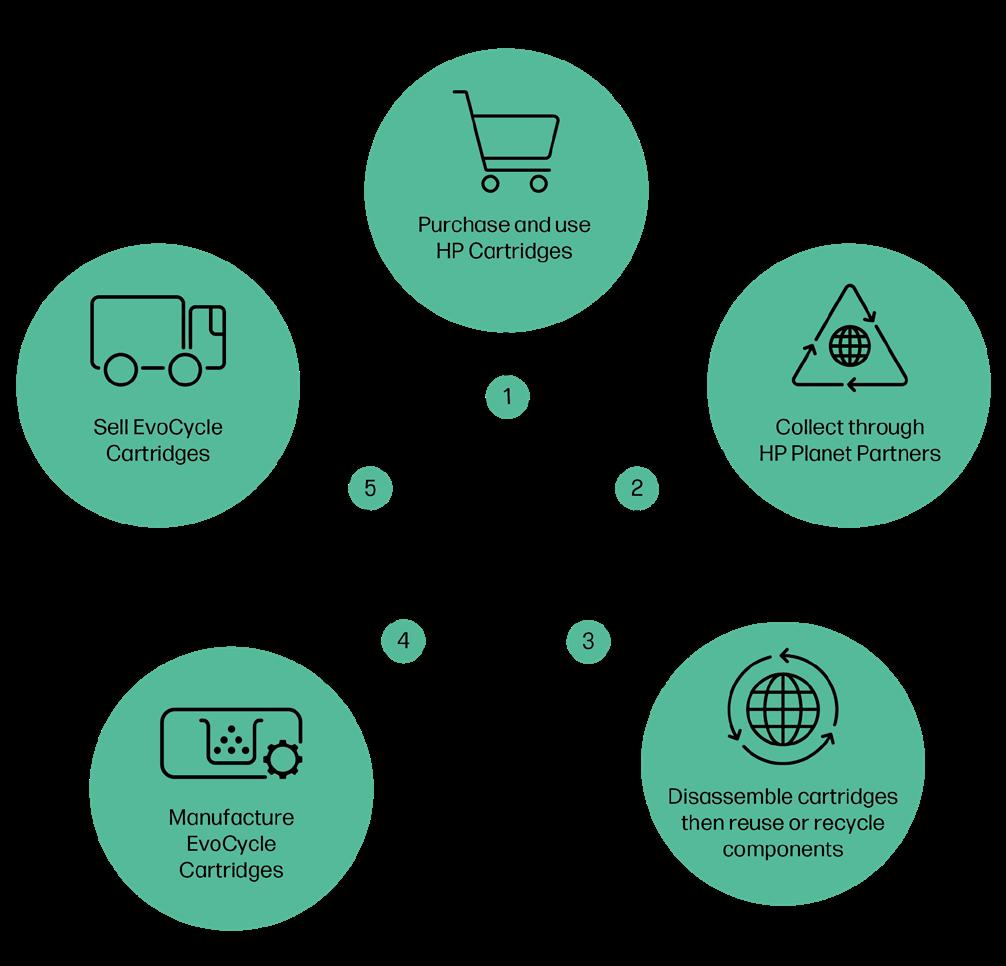
The UK can no longer afford to ignore the full social and environmental costs of procurement decisions, and mandating sustainable procurement for products across government will foster our green economy and support the UK’s path to Net Zero.
By ensuring the environmental credentials of the products and services we buy as a nation, are as important as the price we pay for them – we will be taking a vital step towards a more sustainable future and strengthening the UK’s position as circular economy world leader. L
hp.com/evocycle
Advertisement Feature
Issue 30.3 | GOVERNMENT BUSINESS MAGAZINE 35 FURTHER INFORMATION
Peatland protection
Restoring our peatlands to carbon sinks is critical for nature and our climate, writes Ailis Watt, peat policy officer, The Wildlife Trusts
Peatlands, moorlands, bogs, wetlands - these fascinatingly wild but often misunderstood habitats have a critical role to play in reversing the interlinked nature and climate crises. Despite covering only 10 per cent of UK land area, they are our largest terrestrial carbon store and lock up more carbon than the forests of the UK, Germany, and France combined Peatlands are home to a variety of highly specialised species, including the UK’s very own carnivorous sundew plant, and sponge-like sphagnum mosses which can hold up to twenty times their own weight in water. Peat is formed in waterlogged conditions at an unhurried rate of just 1mm per year. This process is

kickstarted when plants – mostly sphagnum moss – are unable to fully decompose due to a lack of oxygen. As a result, the carbon stored within plants is locked away within peat.
Benefits
Healthy peatlands not only deliver benefits for nature and climate; they also deliver vital ecosystem services to the public. By holding back water during storm surges, they protect downstream communities from flooding, while also acting as a source for over 70 per cent of the UK’s drinking water. Healthy peatlands also act as natural filters, improving water quality and reducing the treatment required by water plants.
Grounds care 36 BUSINESS INFORMATION FOR LOCAL AND CENTRAL GOVERNMENT | www.governmentbusiness.co.uk
Under threat
However, 80 per cent of the UK’s peatlands are now classified as degraded and face persistent threats. Peat is still commercially extracted for use in horticultural products such as bagged compost and potted plants, and in the lowlands, peatlands are widely drained for agriculture. Other threats include burning for grouse moor management, a practice which dries out and transforms the landscape to create habitat more suited to grouse. This results in a loss of traditional bog species such as sphagnum mosses, cotton grasses and curlews.
The implications of these practices are devastating. Currently, emissions from degraded peatlands make up four per cent of the UK’s total annual greenhouse gas emissions – humans have transformed peatlands from carbon sinks to carbon emitters. The UK is also one of the most nature-depleted countries in the world, and with the loss of critical habitats such as peatlands, nature declines are exacerbated.
That’s why The Wildlife Trusts are urging the UK Government to: ban the extraction
and commercial trade of peat immediately, ban all horticultural uses of peat as soon as parliamentary timeframes allow, or by 2024 at the latest and restore all peatlands damaged by the removal of peat by 2030.
The Wildlife Trusts are working to ensure peatlands play a key role in tackling the nature and climate crises. Across England alone, Trusts have collectively restored over 50,000 hectares of peatland, equivalent to 123,000 football pitches. These activities are putting nature on a path to recovery whilst helping to halt the vast quantities of CO2 that degraded peatlands are emitting into our already warming atmosphere. Here are a few examples of peatland restoration projects across the Trusts.

Peatland Progress – a new vision for Fens
The Wildlife Trust for Bedfordshire, Cambridgeshire & Northamptonshire (BCN) is working on a large-scale transformation of the landscape of the Great Fen . An £8 million Heritage Horizons grant from the National Lottery Heritage Fund has enabled the E
Grounds care
Issue 30.3 | GOVERNMENT BUSINESS MAGAZINE 37
Currently, emissions from degraded peatlands make up four per cent of the UK’s total annual greenhouse gas emissions
F Trust to purchase a large area of land that, crucially, will result in the connection of the two halves of the Great Fen for the first time since the 1850s. This will create a huge nature recovery network, offering species such as otters and bitterns the space they need to thrive. The Trust will then get to work restoring the highly degraded landscape by investing in water storage to ensure the site remains wet. This will be a significant contribution to reducing carbon emissions as well as safeguarding several hundreds of thousands of tonnes of carbon in the Great Fen peat according to experts at Cranfield University.
Landscape-scale blanket bog restoration in Yorkshire
The blanket bogs of Yorkshire are a globally rare habitat which are home to amazing wildlife and store over 27 million tonnes of carbon. However, as a result of government incentives for agricultural improvement between the 1950s and 80s, these habitats have become heavily degraded, and the landscape is now scarred by drainage channels and erosion. Yorkshire Wildlife Trust is a leading partner in Yorkshire Peat Partnership (YPP), which works to coordinate restoration across the Yorkshire Dales and North York Moors National Parks, and Nidderdale Area of Outstanding Natural Beauty. Here, the Partnership is working to restore the natural hydrology of peatlands and has, so far, blocked over 2,222 kilometres of drains
– equivalent to more than twice the length of the UK. In addition to rewetting, YPP has now planted over one and half million plug plants to help bring 41,469 ha of upland peatland into restoration management.


Alternative approaches to farming in the northwest
In the northwest, 98 per cent of lowland peatlands have been destroyed through drainage for extraction, agriculture, and development. The Wildlife Trust for Lancashire, Manchester & North Merseyside is pioneering an altogether new approach to peatland restoration. Situated at Winmarleigh Moss, Lancashire’s best example of a lowland raised
Grounds care 38
The blanket bogs of Yorkshire are a globally rare habitat which are home to amazing wildlife and store over 27 million tonnes of carbon
bog has now been all but destroyed through drainage and conversion to farmland. So far, the Trust has re-wetted the once-drained farmland and planted over 150,000 plugs of sphagnum moss. In the first year alone, an 86 per cent reduction in carbon emissions has been recorded, and the Trust expects that the carbon farm will become a net carbon sink once a full cover of vegetation is established. In taking this approach, the Trust, working with Manchester Metropolitan University (MMU), demonstrates how soil carbon can be protected while the financial viability of land for farmers and landowners can be maintained. This is a particularly important project given that it is lowland agricultural soils like these which produce the vast majority of the UK’s peatland emissions. The Trust is also pioneering alternative methods of farming at Rindle Moss in Greater Manchester. Here, the Trust is farming crops, but does so on rewetted peat soils – a technique known as ‘paludiculture’.

Restoration of ancient wetland habitats at Cors y Sarnau, North Wales
Once a shallow lake, today Cors y Sarnau is a rare peatland habitat that is of national importance to Wales. Here, visitors can experience first-hand the succession of the land from lake to wet woodland. In the summer months, the site is home to migrating warblers who travel from Africa and southern Europe to nest in the dense scrub. Year round, the site is home to grass snakes, common lizards, and plants such as the carnivorous (insect-eating) sundew. North Wales Wildlife Trust has been able to nearly
double the size of its nature reserve and is now working to restore additional habitat by removing vast swathes of non-native conifer plantations. Thanks to funding from CarePeat – an Interreg North-West Europe project involving 12 partners – in addition to funding from Natural Resources Wales, it is carrying out hydrological repairs and controlling the spread of scrub and invasive non-native species, allowing native wetland species to flourish. Working with MMU, carbon emissions are also being monitored in order to gauge the speed at which the site can be transformed from a carbon source into a carbon sink. The Trust hopes to be able to use this data to advocate for the more sustainable management of peatlands both in Wales and across the UK. Reversing the decline of UK peatlands is no small undertaking and projects like these demonstrate the importance of working in partnership with local stakeholders. However, without greater Government support, UK peatlands will continue on their trajectory of decline.
www.wildlifetrusts.org

Ideal for councils, parks and public spaces our products have the aesthetics of wood with the durability of plastic. There’s no





Our extensive range includes: Commemorative Furniture customised with Engravings & Plaques, Seats, Benches, Picnic Tables, Chairs & Dining Sets, Children’s Range of Seats, Benches & Tables, Nature Range including Planters, Bird Tables & Nest Boxes. Maintenance Free Made from 100% recycled plastic Splinter-free and never rot Made in Derbyshire Built to last a lifetime 2023 T HE KING’SAWARDS FORENTERPRIS E SUSTAINABLE DEVELOPMENT Phone: 01629 820011 • Email: info@tdp.co.uk TDP Limited, Derby Road, Wirksworth, Derbyshire DE4 4BG
www.tdp.co.uk
resistant so there’s no need for maintenance. MADE FROM 100% RECYCLED UK PLASTIC WASTE
knots, splitting or rotting and everything is graffiti
OUTDOOR FURNITURE
L
FURTHER INFORMATION Grounds care Issue 30.3 | GOVERNMENT BUSINESS MAGAZINE 39
Invasive Weed Management Ltd. Are passionate about bio and non-native invasive species industry. We have over a decade worth of experience working in this sector for local authorities, blue chip companies, developers and residential property owners.

WHO ARE WE?
We specialise in non-native weed solutions primarily Japanese Knotweed, Giant Hogweed, Himalayan Balsam but we can offer solutions for 100’s of other land and aquatic species. FREE survey, identification report and remediation quotation for any site containing a non-native, invasive species.
Not sure if a plant your dealing with is actually Japanese Knotweed? Speak to one of our experts who can identify any plant just by sending them a few pictures on email or WhatsApp.
With over 12 regional offices, we offer full nationwide coverage, and experts on your doorstep.
Build staff confidence by being able to identify Japanese Knotweed, understand the latest RICS changes and much more by receiving in-house training from one of our experts.
Did you know that If you have a property or development site with a non-native weed issue, applying the appropriate insurance backed guarantee can still enable a project to commence or a sale to complete.

IWM are one of a handful of consultants that are INNSA and PCA accredited This enables us to provide an Insurance backed guarantee with every project, and offering you full peace of mind.



ADDITIONAL SERVICES





If you need assistance with plant identification WhatsApp on 07736 975754. For a site visit, quotation or general enquiry call 0800 6785867 or email info@invasiveweedmanagement.co

0800 6785867 info@invasiveweedmanagement.co www.invasiveweedmanagement.co
Japanese knotweed and local councils
Daniel Docking of the Property Care Association (PCA) explains best practice for local authorities dealing with Japanese knotweed

The effective management of Japanese knotweed has become a top priority for many councils. Dubbed as one of the most invasive plants in the world, Japanese knotweed can be found in every county of the United Kingdom, and its notoriety has been gained mostly due to its presence within the built environment, affecting a homeowner’s ability to obtain mortgages from financial institutions and its alleged destructive capabilities.
As this invasive non-native plant is tied to legislation, we have seen a rise in nuisance cases due to mismanagement and/or encroachment. This is forcing individuals, organisations, and councils to responsibly manage infestations, creating a significant strain on finite resources and shrinking budgets.
A legal responsibility
A common misconception is that it’s illegal to even have Japanese knotweed present on your land. This is not the case; however, councils do have a legal responsibility to manage invasive species within their areas of jurisdiction. This core responsibility is outlined in the Environmental Protection Act 1990 and Wildlife and Countryside Act 1981, and under Section 14(2) of the Wildlife and Countryside Act 1981, it states it is an offence to plant or cause Japanese knotweed to grow in the “wild”.
A growing problem for many councils
Councils have a duty to ensure that Japanese knotweed is managed effectively to prevent it from causing harm to the environment, E
Invasive Plants Issue 30.3 | GOVERNMENT BUSINESS MAGAZINE 41



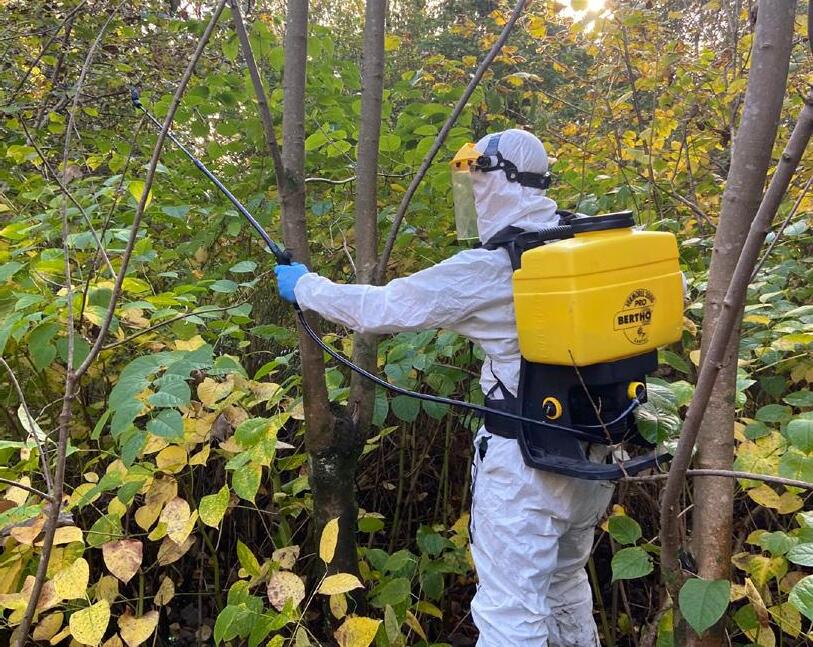


WE ARE INVASIVE WEED REMOVAL EXPERTS WHO SERVE THE DOMESTIC, CONSTRUCTION AND COMMERCIAL MARKETS We work with large public and private landowners to proactively identify and manage infestations that could otherwise delay or prevent development and use of their land. Too often we also see results of not being proactive! 0800 634 9275 info@clearsafeknotweed.co.uk www.clearsafeknotweed.co.uk FREE No obligation Japanese Knotweed Survey within 48 hrs ENQUIRE TODAY
F property, and infrastructure. A recent court case in 2023 Davies Vs Bridgend County Borough Council, only further highlights the importance of managing Japanese Knotweed. In summary, Mr Davies sought legal action against Bridgend Council, where it was deemed that the respondent was in breach of the relevant duty in nuisance owed to the appellant as a neighbour, starting from 2013 until 2018 when a reasonable and effective treatment programme finally started. Although an expert identified Japanese knotweed being present on the respondent’s land for over 50 years prior, Bridgend Council failed to take any reasonable action in reducing the spread of the plant.
Impact on the built environment
Japanese knotweed has the capability of spreading from roughly a thumbnail size of rhizome. The plant’s strong and extensive root system can penetrate small pre-existing cracks within concrete, tarmac, retaining walls and other materials, causing further damage as it grows and exploits these weaknesses. Japanese knotweed often grows in areas that are difficult to access, such as waterways and river embankments. Soil erosion can dislodge active rhizomes, where it will continue downstream, creating a new infestation and creating a continuing cycle or reinfestation along the river embankment.
If Japanese knotweed is identified on councilowned land, financial institutions may consider imposing lending restrictions, resulting in difficulty in selling or leasing the land until a suitable management plan is implemented. Costly repairs, potential lost revenue and environmental impacts are just a few E


Japanese knotweed has the capability of spreading from roughly a thumbnail size of rhizome
Issue 30.3 | GOVERNMENT BUSINESS MAGAZINE 43
Invasive Plants
JAPANESE KNOTWEED SPECIALISTS BASED IN STOCKPORT, MANCHESTER



We are fully certified surveyors holding all NPTC qualifications with regards to herbicide treatments and can offer insurance backed guarantees. We also undertake Japanese Knotweed excavation on a commercial basis. We’re members of the Property Care Association.


We are a professional, reliable and cost effective company.

FREE ID SERVICE
F considerations for councils when setting goals to actively manage this invasive plant, which currently costs the UK economy a staggering £165 million per year.
An established invasive weeds industry
Despite the challenges posed by Japanese knotweed, there are some grounds for optimism. A maturing specialist Japanese knotweed industry, established in the early noughties, has seen a rise of trained experts capable of tackling this invasive plant. Plant identification apps have helped to increase awareness of the issue to encourage more people to report sightings of Japanese knotweed and help prevent the further spread.
Strategies for managing Japanese knotweed

There are several strategies which councils can adopt to manage Japanese knotweed successfully.
Early Detection & Rapid Response
Implementing an Early Detection and Rapid Response (EDRR) is an approach aimed at identifying and treating Japanese knotweed before it has the opportunity to spread. This involves training staff or using specialist companies with qualified surveyors (Certificated Surveyors in Japanese knotweed) to identify and implement a process for reporting and responding to sightings of the plant.
EDRR is especially effective in areas where the plant may be at a high risk of spreading due to ground maintenance, high public foot traffic, or in areas which are unlikely to be developed such as roadside verges or public open spaces.
Biosecurity measures
Implementing appropriate biosecurity measures will reduce the likelihood of potential spread E

Invasive Plants
Issue 30.3 | GOVERNMENT BUSINESS MAGAZINE 45
A maturing specialist Japanese knotweed industry, established in the early noughties, has seen a rise of trained experts
F by fencing off an area where Japanese knotweed is present, and signposting will raise awareness of its presence to the public or council workers. This can reduce the overall long-term cost and by creating a proactive response to a successful identification, should be considered as a priority.
Surveys & site-specific reports
An invasive species survey is recommended for any development project at its preconstruction phase to establish the presence of any invasive plant which could later affect the project. It’s vital these are conducted by competent CSJK surveyors who have the specialist skills and knowledge to be able to identify any invasive plants. A site-specific report will provide suitable remediation solutions which are applicable to the project needs and timescale.
Herbicide control
Once infestations are identified, a crucial task is to manage these areas. Herbicide control is a cost-effective strategy for managing Japanese knotweed and can be effective if applied correctly. Using this approach should be carried out in conjunction with an Integrated Weed Management ethos, creating a sustainable approach where herbicides are used to target specific plants in an extremely controlled manner.
Using competent and trained professionals with the PCA Qualified Technician (PCAQT) in Japanese knotweed, should be considered as the minimum requirement for individuals undertaking the task of managing the plant with herbicides. Overdosing or using too much herbicide within a single season can often have detrimental effects, causing the plant to enter a temporary dormancy. This will cause the plant to “hibernate” producing little or no active growth within a single season, however due to
the large energy reserves within the rhizomes, a stronger reoccurrence will likely be seen once this temporary dormancy breaks.
Properly applied applications of herbicide over a several year period will reduce the plant’s capacity to spread by slowly removing the large energy reserves within the rhizome. Furthermore, it will reduce the plant’s capacity to cause damage to any built or landscaping features and further reduce the negative impacts on the environment. This management strategy does not remove the plant and its propagules from the soil, but simply manages it in situ, leaving restrictions on-site if there are future developments.
Excavations
Excavations can provide an alternative method for addressing Japanese knotweed,

46
An invasive species survey is recommended for any development project at its pre-construction phase
although not as cost effective in comparison to herbicide control. This strategy involves removing the rhizome from the soil and carting any contaminated material away to an EA approved landfill. Complete removal comes with a high price tag; although various possibilities are available, all excavation options require a high level of speciality and should only be undertaken by approved Japanese knotweed contractors.
Japanese knotweed is manageable with the right help






As we said earlier, Japanese knotweed is manageable, but failure to successfully control this plant can cause severe economic and environment damage, with significant resources absorbed by it. Recent innovations have led to the use of sniffer dogs in identifying the smallest amount of rhizome on site, and drone technology has made previously inaccessible embankments viable for surveillance.
Whilst this may be looking somewhat into the distance for many local councils, for now, implementing EDDR strategies and the help of specialist experts, will provide local councils
with opportunities to recapture land which may have been lost to this non-native invasive plant. L
www.property-care.org
INFORMATION Issue 30.3 | GOVERNMENT BUSINESS MAGAZINE 47 GET IN TOUCH NOW Experts in Japanese Knotweed Removal & Treatment for Residential & Commercial. Our Experienced Specialists are Ready to Eradicate Your Problem. Call us now on: 01883 336602 or 07799 412005
FURTHER
Recoveries made to date from our reviews:






Duplicates / Overpayments: £100m


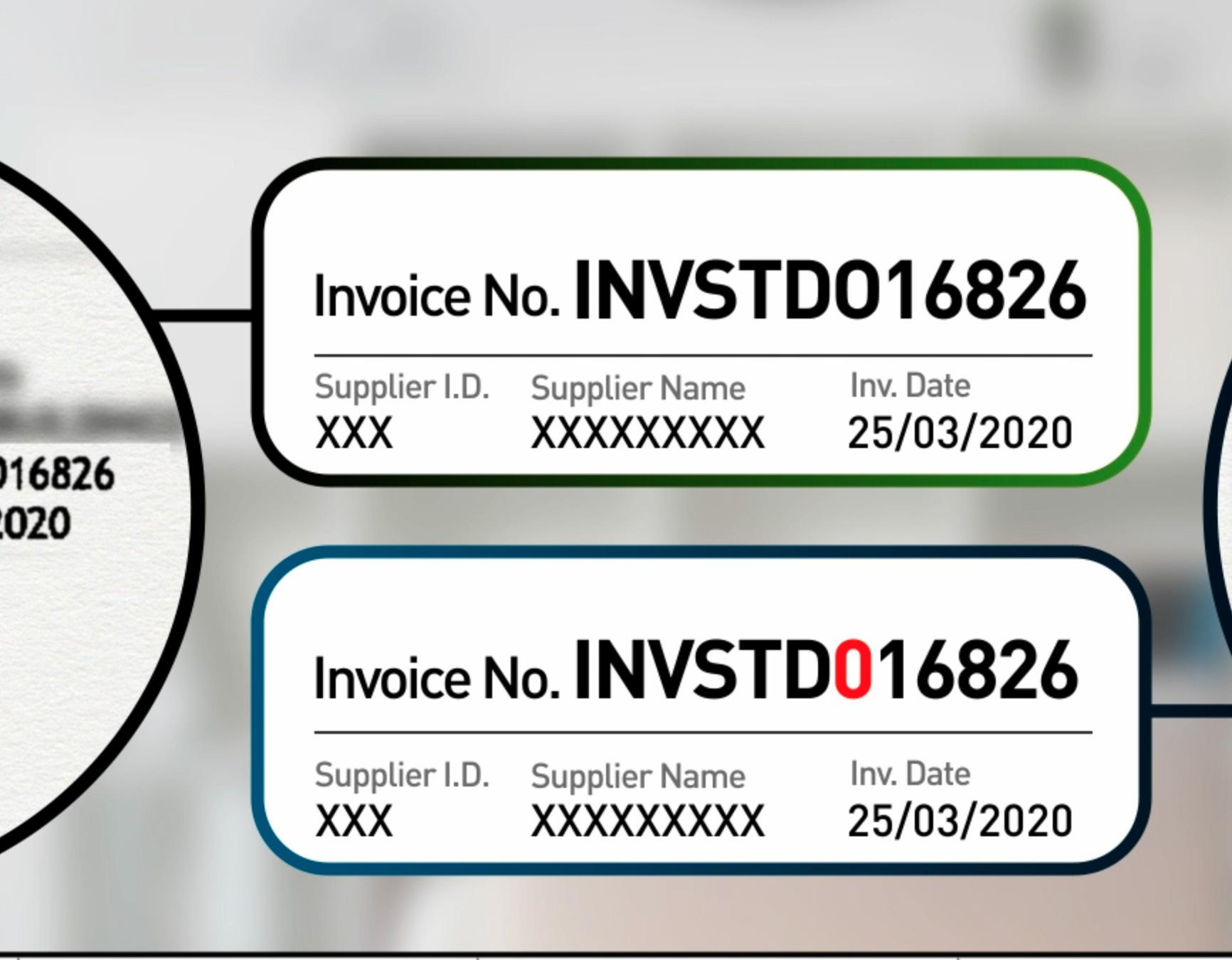
Contract Compliance: £10m








Statement Credits: £20m
VAT: £10m


At the forefront of Spend Recovery Services VISUALISING THE INVISIBLE Accounts
twice2much.com I 0344 225 2090 eview of cover tilising geted is Contac 90 ing the review of t also recover Teams, utilising d unbudgeted alysis Contact us on 0344 225 2090 covery Auditing, involving t o identify anomalies but als ers on behalf of Clients s’ Finance and/or Audit Team rate often unknown and un al windfalls very Analy C t us on 0344 225 2090 ice2much specialises in Client’s historical spend monies fro e work unobtrusively wi our own expert resource Spend Re financial windfalls 25 2090 iew of ver ising ted s Contact us on 0344 225 2090 the review of so recover ms, utilising nbudgeted ysis Contact us on 0344 225 2090 volving the review of es but also recover ents udit Teams, utilising n and unbudgeted nalysis Contact us on 0344 225 2090
Payable Health Check
specialises in ‘Spend Recovery Services’, working with Finance Directors, Accounts Payable Managers and Heads of Audit providing a comprehensive
review of
Accounts Payable Spend.
We
provide the time, resource and expertise that many in-house teams cannot justify resourcing internally.
Our Health Checks are carried out on a NO RECOVERY – NO FEE basis.
ecovery Analysis
The way ahead for digital government under Austerity 2.0
Clayton Smith is a club executive at Zaizi and was previously deputy director for change and digital delivery at the Cabinet Office. He explains how lessons from the last round of austerity can help government departments advance digital public services despite constraints
Sir Tony Blair and Lord Hague recently made waves with a report that called for digital ID cards for all. Their big idea is that this will make it easier and more secure for people to access digital public services. Some will agree with the idea. As we’ve seen with national ID proposals over the years, many others will not.
What’s hard to disagree with is their belief that the future success of the UK requires a fundamental rethink that embraces the digital revolution. More ambitious thinking is needed across government and wider industry.

Which brings us to an interesting question. How is anyone going to achieve genuinely transformational aims under the new era of Austerity 2.0? And make sure the transformation
is based on user needs? The Institute for Government, a non-partisan think-tank, recently said that arresting the decline of public services will require significant injections of cash that the current budget doesn’t provide. So where will that leave the development of digital services?
The answer is not a simple one. But it starts with thinking practically. In the short term, first we need to figure out what we can learn from the experience of digitising services under Austerity 1.0 that happened in the last decade. That means we need to redefine relationships between government departments and their consulting partners. We also need to define ways we can not only reduce costs through E

Digital he review of o recover ms, utilising budgeted ysis Spend Recovery Auditing, involving the review of not just to identify anomalies but also recover om Suppliers on behalf of Clients ith Clients’ Finance and/or Audit Teams, utilising s to generate often unknown and unbudgeted financial windfalls
Contact us on 0344 225 2090 Issue 30.3 | GOVERNMENT BUSINESS MAGAZINE 49
F digitisation, but also deliver services that are both more sustainable and relevant to peoples’ needs. By doing so, we can provide better ROI so that more money can be redirected back into the innovation that will make a critical longterm difference.
Learning from the recent past, three key things need to happen to make sure we travel in the right direction.
Focus on users to influence policy
During the first round of austerity, we largely digitised the way people transact with government. The idea was to turn manual processes into digital ones and save costs. The business case was straightforward – based on the fact that it’s demonstrably cheaper to serve people online (where this was the right thing to do) than over the phone or in person.
This approach met the immediate cost-cutting need at the time. It was picking off low-hanging fruit. What it didn’t do was investigate whether the digital services that departments created could have solved deeper problems that have a bigger impact. For example, by understanding and making better use of data.

Under Austerity 2.0 this approach needs to change. Government digital projects need to start with a key question. “Rather than simply saving costs through automation, are there changes we could make at a policy level that could help us deliver an effective, joined up, user-centred and data-driven service that solves bigger problems?”
An example: The Department for Levelling Up, Housing and Communities recently completed a project that targets homelessness. To get to the root of the real problem, it asked local authorities and vulnerable tenants what they thought would make their life easier. This outcome-driven, user-centred research has led to the proposal of new legislation that will allow local authorities to share data across boundaries and track rogue landlords more easily.
In the short term, this will result in a digital service that will help to reduce the cost of tracing and monitoring landlords. But it will also help to tackle a root cause of homelessness that eats up health and social care budgets. That’s a big advance from the way things worked 10 years ago. It’s also a clear indicator of how digital service development can drive efficiencies that help manage the impact of budget cuts while serving our society in a more transformational way.
Invest in continual improvement
A key failing of digital projects during Austerity 1.0 was the lack of investment in services beyond launch. Little thought was given to continual improvement.
This is another thing that needs to change –not least because that lack of investment has proved to be a false saving. At the moment, government departments have to bear the cost of asking suppliers to rebuild a service when policies change. They would be in a better position if they had invested some of the cost savings they achieved into growing the internal capability needed to make those changes themselves.
That’s what needs to happen from now on. For their part, IT and digital consultancies need to pass on their knowledge and upskill local government teams once a project is completed. That will make digital services much more sustainable in the long term.
Digital 50
Mariana Mazzucato, Professor in the Economics of Innovation and Public Value at University College London, has recently discussed this issue in her new book, The Big Con. She argues that too many consultancies prevent the public sector from developing inhouse capabilities by keeping knowledge to themselves. Their crime, in her eyes, is that they don’t provide government departments with the means to work independently of them. As she said in a recent article in the Financial Times, “a therapist who has their client in therapy forever obviously isn’t a very good therapist.” She makes a valid point.
That said, it’s also important to remember that external consultants can do things the civil service can’t do on its own. The best value is delivered when both sides focus on what they do best, but with a clear focus on sustainability beyond contracts or specific statements of work.
Embrace open source platforms
One of the big constraints for the government when it was digitising services in the 2010s was its reliance on locked-in relationships with legacy applications and technology suppliers. Moving forward, government departments must focus on ending those relationships by adopting open source platforms.
The Central Digital and Data Office’s ‘Be open and use source’ pages on Gov.uk provide clear guidance on this. The guidance describes
how digital projects can benefit projects by saving time and resources, while also lowering implementation and running costs.

At the end of this new round of austerity, we will hopefully see that government departments have fully embraced this opportunity to reduce costs and build more flexible services. And use the time and money they save to focus on the innovation needed to advance the delivery of digital public services based on user needs now and in the future.

A more sustainable way forward
Aside from the controversial call for digital ID cards, the ‘A New National Purpose’ report by Messrs Blair and Hague makes several interesting recommendations that could help to advance the UK digitally. It talks about making greater use of AI in schools and healthcare settings, for example, and the need for a radical shift in government’s approach to data.
These are long-term future ambitions that may or may not be followed up. In the meantime, government departments should learn from the mistakes of the recent past so they can deliver the services our society needs to move forward despite present budget constraints. L
Digital Issue 30.3 | GOVERNMENT BUSINESS MAGAZINE 51
Government departments should learn from the mistakes of the recent past
Transforming public procurement

Public procurement is the largest market in the UK. It accounts for around a quarter of all government spending, and it’s growing rapidly. By 2030, it’s estimated that procurement will account for 30 per cent of total government expenditure. But procurement professionals in UK government and local authorities face a number of daily challenges. In this article, we will look at some of the challenges and suggest ways to overcome them. For further advice direct from the policy makers, take advantage of your FREE Government Business ticket to the Public Sector Show on 4th July: www.publicsectorshow.co.uk
Lack of transparency
One of the biggest challenges for public procurement professionals is the lack of transparency in the procurement process. There have been instances where contracts have been awarded to companies without proper competition or evaluation. This has led to accusations of corruption and favouritism. To overcome this challenge, it is crucial to establish clear and transparent procurement procedures that are followed consistently across all departments and local authorities. There should be a clear set of guidelines that outline the procurement process, including how bids are evaluated, and how contracts are awarded.
Limited budgets
Another major challenge for procurement and commercial professionals is limited budgets.
Public services are under increasing pressure to deliver more with less, and this is particularly true for procurement. Local authorities have seen significant budget cuts in recent years, and this has impacted their ability to procure goods and services. To overcome this challenge, local authorities should work closely with suppliers to negotiate better deals and explore opportunities to share resources and services with other local authorities.

Complex regulations
Procurement regulations in the UK can be complex and challenging to navigate. This is especially true for smaller departments and organisations who may not have the resources or expertise to understand and comply with the regulations. The complexity of these regulations can also make it difficult

Public Sector Show 52
to ensure you are actually complying with all the necessary requirements. It is for this reason that the Procurement Bill, which was introduced in Parliament on 20th June, aims to simplify procurement rules and make them more consistent across different sectors and public authorities. To overcome the challenge, working in tandem with other LAs and government organisations to understand these new, simplified rules, can help procurement professionals to implement them within their own department and answer questions they have collaboratively.
Lack of innovation
Innovation is crucial for driving efficiency and delivering better value for taxpayers, however, the procurement process itself can sometimes be a barrier to innovation. By engaging suppliers and including them in your internal conversations you can start to collaboratively address the challenges being faced and explore new, innovative solutions together. This more collaborative approach to procurement could drive much higher levels of innovation and help to embed the innovation culture that the latest procurement reforms are looking to support.
Lack of diversity
Public procurement professionals have a duty to ensure that the purchasing process is fair and equitable, however, the current processes can make it difficult for SMEs to compete for contracts – the LGA note that, of the 33 per cent of public spending that the Government proposed would go to SME contracts back in 2015, only 21 per cent of it actually did by 2021.
The Procurement Bill should go some way to overcoming this challenge, but individuals can also help by actively encouraging diverse suppliers to bid for contracts. Working with these suppliers to help them navigate your procurement processes and engaging them from the start is a good way to start this.
Proactively implementing change
In conclusion, the challenges facing the UK government and local authorities in their procurement processes are significant, but they can be overcome. On 4th July, Government Business readers can get free tickets to attend the Public Sector Show in London – one full day of collaboration and networking, plus advice and real-life case studies on how to put value for money, public benefit, transparency, and integrity at the heart of the UK’s public procurement system.
Speakers include: Competition and Markets Authority, with advice on how to reduce the risk of anti-competitive behaviour and what to do if you do identify any; Lucy Sydney - head of strategic relationships and procurement reform at the Cabinet Office, speaking about the Procurement Bill and how to implement the new changes within our day to day; Sam Markey - ecosystem director for place leadership at Connected Places Catapult, discussing practical ways to drive innovation within procurement at local authorities and within central government. You’ll also get to speak direct to a host of suppliers and framework managers to explore opportunities, and to share experiences with 300+ other procurement and commercial professionals facing similar challenges. L

FURTHER INFORMATION
Public Sector Show
Get your free public sector ticket at www.publicsectorshow.co.uk Issue 30.3 | GOVERNMENT BUSINESS MAGAZINE 53
It’s not just on the track where all the action happens at Aintree Racecourse
At Aintree Racecourse, it’s not just on the track where all the action happens Renowned for world class horse racing, we also offer versatile and flexible spaces, delivering exceptional quality conferences and events

There really is nowhere quite like Aintree Racecourse. Steeped in history, drama, triumph and achievement, it’s easy to see why it has built an enviable reputation as one of the top event venues in the country - the home of champions and legends, it is simply unique.
Located within easy reach of the City of Liverpool, with it’s airport, motorway links and railway networks, Aintree Racecourse offers an accessible and exciting environment in which to hold events, either indoors or out, amongst acres of lush green parkland.
With 14 flexible spaces set within five selfcontained grandstands, allowing for capacities of up to 600 delegates, alongside 3700sqm of hard standing exhibition space for up to 20,000 people and free parking for 1800 cars, Aintree Racecourse is capable of meeting the most demanding of event briefs.
The same dedicated team that delivers one of the biggest sporting events of the year, The Randox Grand National, will be on hand throughout to offer their passion and expertise, whilst ensuring that all aspects of your event run smoothly.
In today’s modern climate, the ability to bring your teams together remains essential, but is harder than ever to achieve. By combining our inspirational sporting legacy with state-ofthe-art facilities, we can help you to create a hybrid meeting with colleagues from all over the world. We have the space and facilities to make the whole process straightforward,
effortless and you’ll discover a stage for conferencing and events that is second to none. It’s vital to keep your colleagues fed and watered throughout your event and our fresh, healthy and delicious food which is thoughtfully and carefully prepared by our team of exceptional chefs is crucial. Ingredients are ethically sourced from local suppliers wherever possible. We tailor the food offerings to our clients’ requirements, so if you fancy having a BBQ menu for a team building day or a light ‘working’ lunch, we cater for all needs, styles, and occasions. Our ever-growing portfolio contains a hugely diverse range of events, from small, high-level meetings through to truly unforgettable gala dinner dances, glamorous product launches and ‘It’s a knockout’ team building events. We really can host it all. L
Please contact our team for further information: 0151 522 2922
aintreeevents@thejockeyclub.co.uk thejockeyclub.co.uk/aintree/venue-hire/

FURTHER INFORMATION
54 BUSINESS INFORMATION FOR LOCAL AND CENTRAL GOVERNMENT | www.governmentbusiness.co.uk Adveretisement Feature
An unusual event venue
Have you thought outside the box when it comes to picking your event venue? It could make your event more memorable and encourage more visitors


With events mostly back to how they were prepandemic, you need to consider how to make your event stand out and attract visitors. One way to do this is to pick a unique or unusual venue.
Choosing a unique venue will create lasting memories for your attendees and make them want to return next year. It will also help your event stand out from any other similar events, taking place around the same time. An unusual venue will give your attendees something to talk about, and they are more likely to share pictures on social media and tell others about it.
It is also likely that using a different venue will attract people to the event in the first place. People will be curious about the venue and they’ll be more likely to turn up to see what it’s all about. A conference at their team’s football stadium? Networking with the penguins at the aquarium? Expo at an art gallery?
First impressions are important, think about the exterior of a venue and how attendees E
Conferences & Events Issue 30.3 | GOVERNMENT BUSINESS MAGAZINE 55
Thames Barrier The View Conference Centre
Thames Barrier The View Conference Centre
Thames Barrier The View Conference Centre
Thames Barrier The View Conference Centre
Unique meeting rooms with views of the River Thames and London. Our rooms are light and spacious and offer various room layouts to suit all occasions. With a range of audio visual equipment.
Unique meeting rooms with views of the River Thames and London. Our rooms are light and spacious and offer various room layouts to suit all occasions. With a range of audio visual equipment.
Unique meeting rooms with views of the River Thames and London. Our rooms are light and spacious and offer various room layouts to suit all occasions. With a range of audio visual equipment.
Unique meeting rooms with views of the River Thames and London. Our rooms are light and spacious and offer various room layouts to suit all occasions. With a range of audio visual equipment.



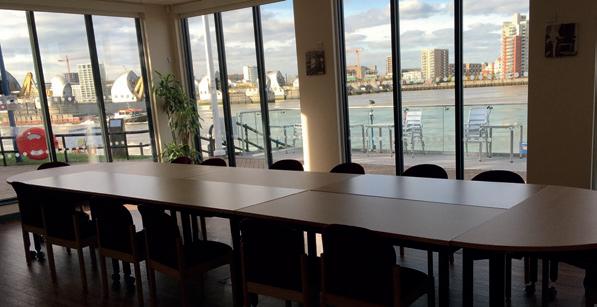






Meeting, event hire for up to 60 people with catering.
Meeting, event hire for up to 60 people with catering.
Meeting, event hire for up to 60 people with catering.
Meeting, event hire for up to 60 people with catering.



Please tephone 0208 305 4188 or email us at Thamesbarriertheview@environment-agency. gov.uk for more details.
Please telephone 0208 305 4161 or email us at Thamesbarriertheview @environment-agency.gov.uk for more details.
Please tephone 0208 305 4188 or email us at Thamesbarriertheview@environment-agency. gov.uk for more details.
Please telephone 0208 305 4161 or email us at Thamesbarriertheview @environment-agency.gov.uk for more details.
Please tephone 0208 305 4188 or email us at Thamesbarriertheview@environment-agency. gov.uk for more details.
Please telephone 0208 305 4161 or email us at Thamesbarriertheview @environment-agency.gov.uk for more details.
Please note there is no access on the Thames Barrier Structure.
Please note there is no access onto the Thames Barrier Structure.
Please note there is no access on the Thames Barrier Structure.
Please note there is no access onto the Thames Barrier Structure.
Please tephone 0208 305 4188 or email us at Thamesbarriertheview@environment-agency. gov.uk for more details.


Please telephone 0208 305 4161 or email us at Thamesbarriertheview @environment-agency.gov.uk for more details.









Please note there is no access on the Thames Barrier Structure.
Please note there is no access onto the Thames Barrier Structure.
Please note there is no access on the Thames Barrier Structure.


Please note there is no access onto the Thames Barrier Structure.




56 BUSINESS INFORMATION FOR LOCAL AND CENTRAL GOVERNMENT | www.governmentbusiness.co.uk
Whitefoot Photography
Whitefoot Photography
An incredible 880sqm space with endless flexibility to accommodate 1200 delegates 23 meeting spaces in total with masses of breakout space Adjoined to the 195 bedroom Aloft Birmingham Eastside hotel Birmingham's newest conference venue YOUR NEXT EVENT AWAITS YOU! YOUR NEXT EVENT AWAITS YOU! www eastsiderooms com 0121 820 6060 events@eastsiderooms com
Whitefoot Photography
F will react when they step inside. If they are excited, they will be more likely to enjoy the event.
Unique venues tend to be more customisable, so there’ll be more opportunities to make them your own and incorporate your own style and branding.
Venues will usually have their own events team, as well as everything you need to run an event, like furniture and AV equipment. They will often have links with caterers as well, so you don’t need to worry about about any of that.
If an event is at an exciting venue like a farm or a football stadium, people are more likely to enjoy it and tell others about it. Being outside and in nature tends to make people more relaxed and at ease (weather-dependent of course).
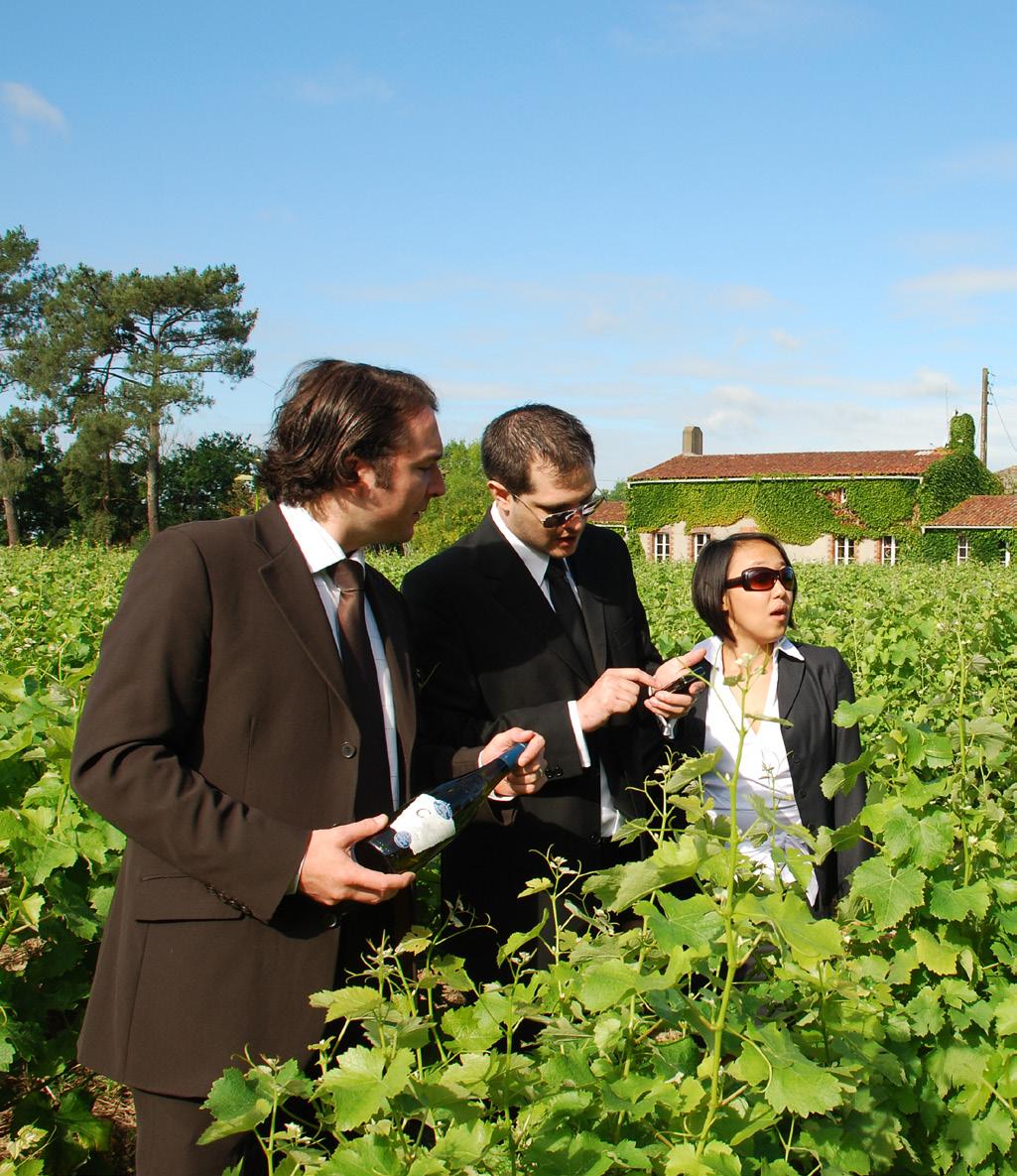

What’s available?
Art galleries and museums provide a great backdrop for photos, for marketing and to share on social media. The artwork and exhibits give attendees something to talk about bring a fun and friendly atmosphere that isn’t all about business.
These venues often have lots of open space, which can be used for stands or tables or for mingling. People rarely get to visit these venues after hours when there is no one else there and this could be a big pull. They also tend to be in city centres, meaning they are easily accessible for attendees, especially those attending by public transport and are great for people needing overnight accommodation.
Warehouses also provide a lot of open space, but in this case, they are simple and empty, meaning you can do what you like with the backdrop and decorations and really make the space your own. If cost is a factor, they are also often on the cheaper side of the options.
On the more out-of-town side of things, historic houses and gardens are a great choice, and many are well practised in handling events. They likely host weddings at weekends, and may be easier than other venues to book during the week. Again, they provide a beautiful background for photos and socialising and look
good in pictures. They tend to have the option to host inside and outside – but make sure you always have an inside option available, because if this spring is anything to go by, rain is likely. Outdoor venues provide lots of space for large numbers of people and allow people to taper off for more private conversation if necessary. Other options might include football stadiums, boats, wineries, rooftop gardens, zoos, farms, the list goes on.
Of course you should always make sure that your event fits your requirements with regards to size, costs, location, branding etc. It is a certainty though that the venue makes the event and a different venue can really be a talking point and attract visitors. L
Conferences & Events
Art galleries and museums provide a great backdrop for photos, for marketing and to share on social media
Issue 30.3 | GOVERNMENT BUSINESS MAGAZINE 57
Improving justice services through digitisation and collaboration
The UK criminal justice system is in a state of constant change from the numerous challenges it faces. Some of these include funding uncertainty, delivering a connected justice system in the digital age, standards of policing, prison and probation reform as well as backlogs due to Covid-19

The system plays a vital role in maintaining law and order, safeguarding the rights and freedoms of citizens, and ensuring that justice is served. However, like any complex system, it faces numerous challenges and is not without its flaws.
Is our criminal justice system working efficiently?
The system has various moving parts. Central government delivers policy and funding which gets disseminated to the justice agencies: police, courts, prisons and probation service. One of the main challenges facing the UK criminal justice system is the sheer volume of cases it handles. This means that the system is under significant pressure to process cases quickly and efficiently, while also ensuring that justice is served.
Victims are a big part of the criminal justice system, but they can often be overlooked. The introduction of the Victims and Prisoners Bill will work to improve victims’ experience.
Donna Jones, police and crime commissioner of Hampshire and Isle of Wight explains the
importance of the bill, “The Victims and Prisoners Bill represents a pivotal moment for the CJS to refocus on victims, putting them at the heart of the system to provide them support when they need it most. At a time when public confidence has been shaken, it is imperative that the government ensures this bill enshrines victims code rights.”
The violence against women and girls (VAWG) strategy has been put in place since 2021, Georgina Henley, head of justice & emergency services at techUK describes the effects of the strategy and their involvement, “this is important area for techUK as we work with industry, policing and justice partners to understand the value of digital, data and technology (DDaT) in securing convictions of violent offenders, preventing offences and supporting victims in their interactions with the justice system. DDaT sits at the heart of an effective and efficient criminal justice system. A system which puts its users at the centre and now more than ever we must see private and public sector collaboration to understand the biggest challenges facing our justice system.”
Modernising Criminal Justice 58
users
Digital transformation in the system
We are now in a golden age of technological advances, that will allow processes to be streamlined such as digitising records. For example, a digital case management system enables all agencies involved in a case to access and share information about the case in realtime, reducing the need for paperwork and improving communication between agencies. Mark Greenhalgh, Detective Chief Superintendent, head of business change, Digital Forensics Programme at Police Digital Service/National Police Chiefs Council shares his thoughts on how digitisation is occurring in police, “The prevalence of technology in all of our lives is clear, the data available is vast and provides both safeguarding and investigative opportunities for policing. Understanding those opportunities, how they are best serviced and what technology is used is key to increasing policing efficiency and effectiveness. Digital Forensic Science is just one element of a digital investigation ‘Jigsaw’. The future of digital investigations and digital forensics needs to be built on an evidence-based approach, have best value and offer effectiveness as key values and more importantly have tangible benefits for Policing, the wider CJS and the Public.”
Future ideas and plans
One of the most significant trends is the increasing use of data and analytics. This includes the use of data to identify patterns of
offending behaviour and predict the likelihood of reoffending. The criminal justice system is also likely to continue to embrace digitisation and other technological advancements. This could include the use of virtual courtrooms and online dispute resolution mechanisms, which could help to reduce costs, increase accessibility, and speed up the resolution of cases.
Kam Stevens, senior digital consultant at Penal Reform Services shares his thoughts about the future of the criminal justice system and technology, “With the use of technology in the criminal justice system rapidly gaining traction, the upcoming Modernising Criminal Justice initiative is the perfect opportunity to showcase these cutting-edge solutions that have the potential to significantly improve the efficiency and effectiveness of the system.”
Join us for the 21st Annual Modernising Criminal Justice Conference at the prestigious QEII Centre in London on 22nd June 2023 for an event like no other and this year’s focus is improving services through digitisation and collaboration.

Modernising Criminal Justice is the only conference that connects like-minded delegates from the entire justice ecosystem. Join Government, justice agencies, industry, academia and frontline practitioners for a day of strategy, networking and supplier evaluation. L
Register your pass herehttps://hubs.la/Q01LGbjk0

Modernising Criminal
Justice
FURTHER INFORMATION
Issue 30.3 | GOVERNMENT BUSINESS MAGAZINE 59
A system which puts its
at the centre and now more than ever we must see private and public sector collaboration to understand the biggest challenges facing our justice system


Your Global eDiscovery experts At Grant Thornton, our multi-disciplinary eDiscovery team helps your organisation come out ahead in the fast-moving litigation environment. Let our experience in matters large and small help you achieve your legal goals. Using our breadth of global expertise, we combine tried and tested technology with innovative software solutions. Talk to our team today. grantthorntonni.com © 2023 Grant Thornton (NI) LLP. All rights reserved. Regulated by Chartered Accountants Ireland (CAI) for a range of investment business activities in the United Kingdom. Grant Thornton Ireland is a member firm of Grant Thornton International Ltd (GTIL). GTIL and the member firms are not a worldwide partnership. Services are delivered by the member firms. GTIL and its member firms are not agents of, and do not obligate, one another and are not liable for one another’s acts or omissions. Please see www.grantthorntonni.com for further details.
RM6336 - eDisclosure and Review Services 2
Crown Commercial Service’s RM6336 Framework allows central government and the wider public sector to access disclosure services for a complete service following the Electronic Discovery Reference Model or by using select elements of this

The framework has been designed with input from government stakeholders, customers and suppliers and provides eDisclosure and eDiscovery services for electronically-stored information. This includes identification, preservation, collection, processing, review, analysis, production, and presentation at trial. The agreement replaces the previous CCS eDisclosure and Review Services agreement RM6203 and will expire on 6 March 2027. Buyers can use a complete service or buy component parts of the disclosure procedure.
Lots
The framework has four lots and 13 suppliers. Lot 1 is for Simple Low Volume Work Service and provides pre-processing, processing, review, production and disclosure services for low volume work. This can include the collection, identification, processing and analysis for electronically stored information (ESI) of no more than 5GB with a security classification of up to and including ‘official’ and ‘official sensitive’ and hardcopy documents of no more than 1,750 pages with a security E
Framework RM6336 Issue 30.3 | GOVERNMENT BUSINESS MAGAZINE 61
For Lot 1, services can only be bought through direct award
F classification of up to and including ‘official’ and ‘official sensitive’.
Lot 2 covers End to End Service up to ‘Official’ and enables access to end-to-end eDisclosure services for documents and data with a security classification of ‘official’ and ‘official sensitive’ or lower. Services in this lot include strategic oversight, advice and support, document identification, data preservation and collection, document processing, document review, document reviewers, document production, disclosure from other opponent parties, presentation at trial, and security requirements.
The third lot is for Document and Reviewers and is for documents and data with a security classification of up to and including ‘official’ and ‘official sensitive’. This lot allows buyers to access document reviewers to review documents and data, tag or add extra information to documents and data to easily label and categorise them, and redact (adapt) documents and data, for example by obscuring or removing personal or sensitive information.
The final lot is End to End Service ‘Secret’ and ‘Top Secret’ and offers access to end to end eDisclosure services for documents and data with a security classification of ‘secret’

and ‘top secret’. Services covered by this lot include strategic oversight, advice and support, document identification, data preservation and collection, document processing, document review, document reviewers, document production, disclosure from other opponent parties, presentation at trial and security requirements.
Buying
For Lot 1, services can only be bought through direct award. For the remaining lots, either direct award or further competition can be used.
To use direct award, the buyer will need to develop a clear specification of their needs and then award the call-off contract by sending the successful supplier a completed and signed framework schedule 6 (this can be done electronically). Then the buyer will need to then notify CCS of the award.
Further competition has a few more steps, and begins with identifying the suppliers who meet your needs, by considering the expression of interest responses you received from suppliers and reviewing the service document which
Framework RM6336
62
suppliers created to help with the selection process. The buyer will then need to develop a specification of needs and use framework schedule 6 to refine contract deliverables. Buyers can then develop further competition award criteria and invite identified suppliers to submit a tender. Further information is available from CCS’s website.
Benefits
The framework offers the opportunity to access a range of market-leading suppliers with fixed rates for standard services and the lot structure is better aligned to customer needs to enable fast and responsive action.
There is a more efficient and streamlined call-off process with simplified documents and commoditised pricing for electronically stored information, which provides clarity and easy comparison.


There is a good proportion of SMEs on the framework and all suppliers must agree with high standards of security.
The agreement provides increased access and availability to new technologies to enhance the efficiency of the service and offers reduced time
for the customer to contract with suppliers and a reduced time period for disclosure. The framework also reduces the cost of procurement. L
https://www.crowncommercial.gov.uk/ agreements/RM6336
FURTHER INFORMATION Framework
Issue 30.3 | GOVERNMENT BUSINESS MAGAZINE 63
RM6336
How can government officials stay protected against ‘hack-for-hire’ cybercriminal gangs?
By Tom Kidwell, Co-Founder, Ecliptic Dynamics and former British Army and UK Government intelligence specialist and internet infrastructure security professional for the public sector
The cybercrime industry has been growing at a staggering rate in recent years, with organisations and individuals across every sector affected. The Government has been put on high alert from potential state-backed cyberattacks as political tensions continue to rise, including possible threats upon the safety and security of politicians and national critical infrastructure. And, recently the Government announced a new strategy to protect the NHS from cyberattacks.
Some of the most notable attacks include the NHS 111 attack that occurred last year, which crippled emergency services across the health service, and the phishing attack on Scottish MP, Stewart McDonald, back in February 2022, which publicly exposed his private work emails. In addition to this, a sting
operation recently revealed that Indian hackfor-hire gangs were targeting UK politicians. These are just a few examples of how threat actors are preying on the public sector which is expected to increase year on year. A recent report found that nearly 47 per cent of data breaches in the public sector weren’t discovered until years after the initial attack, and the overall cost of cybercrime to businesses is set to reach $10.5 tn a year by 2025, making it one of the largest economies in the world, and one of the most lucrative types of crime globally. For government officials or other public sector professionals, the hack-for-hire groups will be of particular concern. Often cyber groups adopt a ‘get in where we can approach’, using simple attack vectors such as phishing. They target whoever they can with fake emails and communications, hoping someone, usually on a company work device, will open a link, installing ransomware or other malware. However, with these hack-for-hire groups, they are incredibly targeted, not only going after specific organisations, but specific people within them. And on top of this, due to current conflicts around the world, foreign States are becoming increasingly involved in cybercrime, with many commissioning malicious activity against other countries; again, placing a target on the back of government officials. So, government professionals need to know how to protect not only their organisation, but also themselves. Here are a few of the best practices professionals can implement to keep themselves secure:

64
Cyber Security
Two Factor Authentication (2FA)
2FA is probably the most effective cybersecurity practice that can be instantly implemented. It is an access management control method, which forces users to provide two forms of identification to access a network, environment, account, or data set. The concept is centered around having something you know (username and password) and something you have (a code or token on your mobile). This means that even if a malicious hacker compromises your work email login credentials for example, they still need access to the unique authentication code that is sent to your trusted device.
Check suspicious links
Even if an email comes from a trusted sender, there’s always the possibility that they themselves have been breached, and the link you’ve just received from them is malicious. As with many walks of life government officials should trust their gut when it comes to cybersecurity. Does something seem off?
Is this a strange email to receive from this individual? Have they used your full name, when they normally use a shortened version?
If you’re thinking about these things, always check the link. You can do this using phishing tests or link scanners, however sometimes an even easier way is to pick up the phone and verify the communication with the sender. In some ways this is similar to 2FA.
Isolate your sensitive work
Malicious hackers will likely be looking to access your work communications or data, sometimes targeting something specific for the purpose of blackmail or extortion.

That’s why it’s crucial to keep more sensitive information and data isolated. This can be done using a different device, or segmenting your data, implementing different access pathways for each part of it. It’s also important to ensure that when browsing the web, or opening sensitive communications, that your work device is also protected. Using ‘virtual machines’ or web isolation platforms means that if you do click on a malicious link, or accidentally download an infected asset, all of the risk is contained, with the software and IT provider absorbing the risk and removing it from the user and their organisation.
What’s more, with web isolation platforms, the user has zero footprint online as the virtual computer is rebuilt entirely from scratch, daily, destroying any viruses – malware,
trackers and online activity related to the user’s work, making it almost impossible to track a user online, leaving government officials to go about their work freely and safely. The public sector remains a top target for cyber gangs, mainly due to the highly valuable and sensitive data it holds, and the vital role public sector officials and organisations play in society. A crippling attack on critical public infrastructure is a real risk, especially with geopolitical tensions high since the war on Ukraine. Despite this, there are steps government workers can take to protect themselves and the organisations they represent. 2FA, checking suspicious links and isolating your work are key however, to enable these things to happen means ensuring that government workers are cybersecurity savvy, trained in knowing what cyber defence procedures to follow. Organisations should have proper governance and control measures in place for officials to abide by as well as an incidence response plan to observe, should a breach occur. It’s a three-step approach – People, Processes and Technology – and following those will help to keep your government officials and organisation secure. L
Issue 30.3 | GOVERNMENT BUSINESS MAGAZINE 65
Cyber Security
Even if an email comes from a trusted sender, there’s always the possibility that they themselves have been breached

Framework RM6259Vertical Application Solutions
Crown Commercial Service’s Vertical Application Solutions Framework offers software-focused solutions to customers to meet the specific needs of their industry, business application or services

Framework RM6259 provides solutions on software licences, associated hardware, app-related consultancy services, software support and maintenance. In the context of the framework, ‘Vertical’ refers to software-based solutions that have been developed specifically or primarily with one particular customer type and use case in mind. Therefore, they are designed for a particular customer ‘vertical’, such as Local Government, Housing, Education etc. and are therefore less likely to be found being used outside of their intended scenario. The framework will run from 7 March 2023 until 6 September 2025 and replaces the Data and Application Solutions framework. The agreement is available to all public sector organisations including: government departments and their arm’s length bodies; devolved administrations; the wider public sector; and third sector organisations. There is also a particular consideration for customers in the blue light, education, local authority and social care sectors. E

Framework RM6259 Issue 30.3 | GOVERNMENT BUSINESS MAGAZINE 67




Join customers including the Foreign, Commonwealth and Development Office, Care Quality Commission, Liverpool City Council and Victim Support using IIZUKA’s Case Manager to securely manage their casework, investigations and reporting. Call us to find out more, or arrange a free demo: Case Manager® Software that makes complex case management simple t: 0121 212 2030 e: info@iizuka.co.uk www.iizuka.co.uk CaseManageris nowavailabletopurchase viaVASandG-Cloud.
F The framework allows buyers to implement, test and provide a range of software solutions; buy cloud-hosted and on-premise software, or a combination of both, under one agreement; and access solution-essential hardware and professional services such as a server for a revenues and benefits software solution and integration with an existing records management system.

Lots
The framework includes 81 suppliers across five different lots.
Lot 1: Business Applications allows buyers to access services including revenue and benefits solution, payment processing and cash receipt and civil enforcement. This lot is primarily targeted towards Local Government customers.

Lot 2 covers Education, Community Health and Social Care Solutions and includes learning applications and platforms, academic scheduling and management solutions, education management system (EMS), community health and social care solutions, and enterprise health solutions. It is designed to enable local government, academic and health customers to access standalone or integrated solutions.
Lot 3 is for Housing, Environmental and Planning Solutions and includes the following services: environmental; planning; building control; local land changes; regulatory services; licensing; property or housing management; geographic information system (GIS); waste management solutions; and built environment.
Lot 4: Citizen Services provides library solutions; democratic and citizen engagement systems; museums systems; sports and recreation systems; registrar systems; and burials and crematoria solutions.
The final lot is for Blue Light solutions and includes the following services: investigation, intelligence, forensics (including digital forensics), case and custody applications; surveillance and reconnaissance; command and control, integrated command and control systems (ICCS); emergency response and crisis management; fraud detection; digital asset management; recording and audio-visual; and data analytics (including management information and business intelligence). E
Lot 3 is for Housing, Environmental and Planning Solutions
Framework RM6259
69








Your own personalised platform for e ective property management and compliance
Produce professional property reports, periodic inspections, building audits, risk assessments, surveys & more using our award winning inspection software. Property Inspect caters for all types of tasks with our unique template builder Health & Safety Certificates Fire Safety Building Inspections Asset Registers Work Orders Start your FREE 14 DAY TRIAL today or speak to one of our account managers uksales@propertyinspect.com 03309 125 005 propertyinspect com/uk/ Proud to be an o cial Crown Commercial Supplier, Property Inspect enhances public sector operations by improving reporting processes, increasing e ciency and reducing costs.
Property Inspection & Operations Software
F Buying
Depending on the needs of the purchasing organisation, services can be bought through further competition or direct award.
Direct award catalogue listings are available on the Government eMarketplace.

Expression of Interest (EOI) is also available, which allows an organisation to go to suppliers with their needs to understand their interest. Those suppliers who decline interest at EOI do not need to be invited to tender.
EOI can help refine the number of suppliers to those with the capacity and specific expertise you are seeking, enables you to more accurately determine the level of evaluation resource required for tender responses and can increase confidence in your timescales and requirements.

When running an EOI, you must send it to all suppliers on the lot, those who reply with a yes can then be invited to tender. Buyers are advised to allow enough time for responses. Five to ten days is suggested, even longer for complex procurements. Buyers must also ensure that there are no material changes to the requirements/Statement of Requirement or timescales given.
To run a further competition, there are two options available. The first is to run an EOI and then a further competition including those suppliers who have not declined their interest in the opportunity. The other option is to run a further competition to all suppliers on the lot.
CCS recommends taking part in premarket engagement before going out to the suppliers on the agreement.
Criteria to consider include quality and price. Factors to consider when evaluating quality include: approach to delivery of the services/methodology, including the strategies, expertise, methods, materials, and procedures in the proposal and technical E
Framework RM6259
71 Issue 30.3 | GOVERNMENT BUSINESS MAGAZINE
Depending on the needs of the purchasing organisation, services can be bought through further competition or direct award
S C O U T S C O U T ® MEET
A state-of-the-art single intelligence platform, that aggregates data sources, including sensitive internal data – saving up to 85% of your time and allowing investigators to spend more time making informed decisions.

With law enforcement agencies responsible for managing and investigating a wide remit, you need to know you have all the intelligence available, and fast.

Our award winning team is unique in having years of experience in law enforcement; with former Policing, Legal, Government and Ministry of Defence careers.

We've been on the front line and are acutely aware of the pain points involved. So if you need to improve the efficiency of your investigations, speak to us today to find out more.
Allow investigators to make better, more informed decisions, free from manually identifying risks and cross-referencing multiple data sources
By bringing internal and external data feeds into one place, Scout® allows you to view an interconnected landscape that will inform your next move.
Highly secure and GDPR compliant, you can analyse results using configurable risk assessments, and gain a holistic view across other existing enquiries
w w w . s y n a l o g i k . c o m
C o n t a c t u s t o f i n d o u t h o w w e c a n h e l p y o u r t e a m
p u b l i c . s e c t o r @ s y n a l o g i k . c o m
<60s
F merit, including the competence, skills, and experience of the management, professional, and technical personnel proposed for the project. Other factors include ways of working, including the proposed management systems and methods, project management tools, software, touchpoints, etc. and social value

criteria in central government tenders
(according to PPN 06/20, social value should account for a minimum of 10 per cent of award criteria in central government tenders).
To evaluate price, things to consider include: Professional Services charges, time and materials, including all costs over the duration of the contract including fixed capital costs, variable tender costs and special adjustments during the contract period; and maintenance and operating costs and software licence costs, including testing a range of licensing models (per user, per device, enterprise wide etc). You should also evaluate hardware costs (as part of a solutions) and support and maintenance costs.
More information on how to buy is available in the customer guide, which provides detailed instruction on the whole process, including how to prepare for tender, how to buy through direct award or further competition and what to do once you have chosen a supplier.
Direct award catalogue listings are available on the Government eMarketplace and there are flexible call-off lengths to suit specific needs. Support and maintenance options are available to help extend a product’s lifecycle. E


Framework RM6259
Social value should account for a minimum of 10 per cent of award
Issue 30.3 | GOVERNMENT BUSINESS MAGAZINE 73
CLICK
READ THE LATEST ISSUE
A RISK MANAGEMENT PLATFORM WITH INTEGRATED INTELLIGENCE
A product designed to solve the challenges of risk management, business continuity and organisational resilience.

· Incident reporting for any event.
· Automated & customised workflows, tasks and forms.

· Integrated mapping and visualisation.

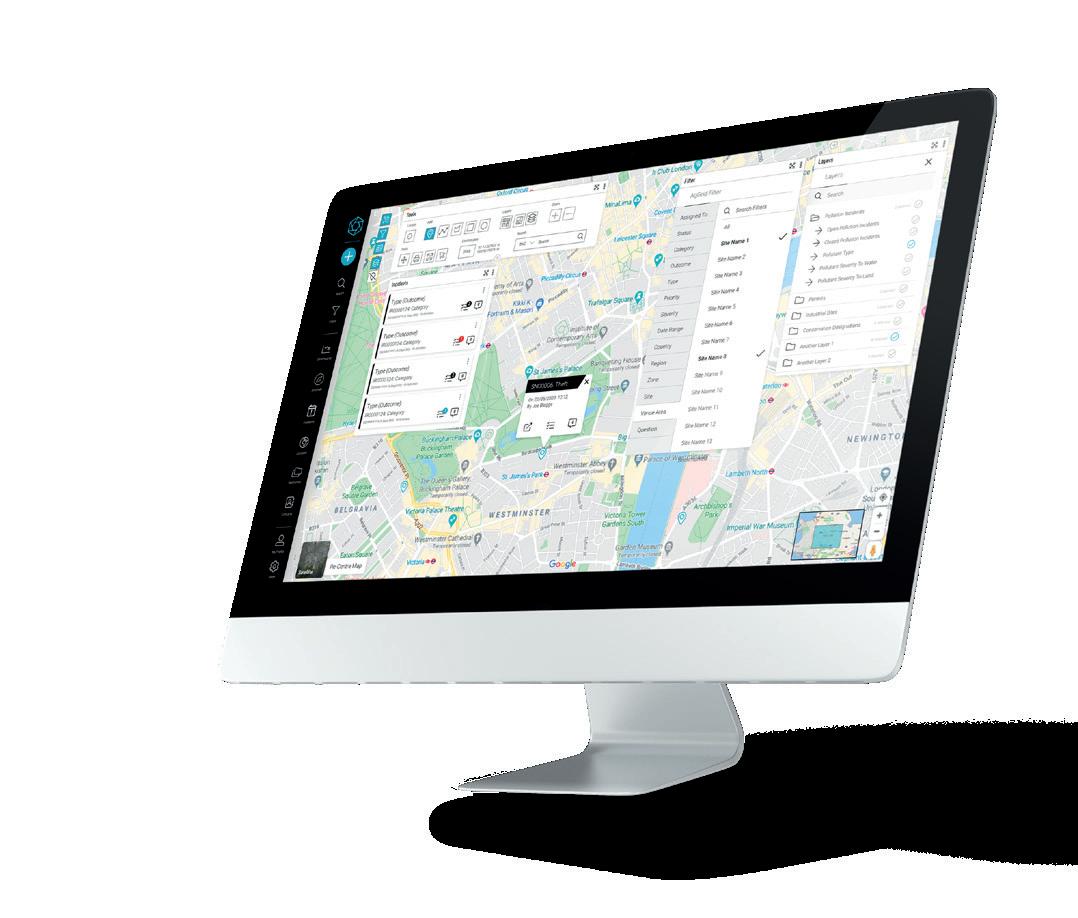
· Alerts, briefings and mass communication.
· Risk assessments, checks and audits.
· Patrol management and asset verification.
· Dashboards and reports.
VISIT OUR WEBSITE: WWW.ZINC.SYSTEMS
Command, control, communication and analysis Operate seamlessly on-the-go with our mobile app Proof of presence and patrol management Create a connected solution through system integrations Evolve your platform using self customisation tools REPORTER VERIFY MARKETPLACE CONSOL ANALYST
HERE TO
· Integrated threat intelligence monitoring. 74 BUSINESS INFORMATION FOR LOCAL AND CENTRAL GOVERNMENT | www.governmentbusiness.co.uk
F Pricing
The framework covers a range of software solutions, spanning a diverse mix of pricing models and charging mechanisms. Therefore, only the supplier’s maximum day rate charges for professional services have been tested. Buyers are encouraged to ask bidders to submit pricing in the most appropriate way for the tender. This could be, for example, bid pricing on a software licence cost basis, or a total cost of service. The CCS category team are able to help establish the most suitable pricing methodology for the requirements of each tender.
Benefits
The framework offers several benefits including providing a route to market to buy a wide range of software solutions that are designed to meet specific sector needs, for example, local authority revenues and benefits and providing fully supported solutions for cloud, on premise or hybrid (a combination of cloud and premise) systems. Other benefits include fully supported solutions for cloud, on premise or hybrid (a combination of cloud and on premise) software systems and a route to market to buy a wide range of software solutions that have been designed to meet specific sector needs, for example local authority revenues and benefits. All lots are available to all public sector customers, and the digital catalogue allows buyers to buy products with a


simple ‘click and buy’ approach. Support and maintenance options are available via a digital catalogue, to help extend a product’s lifecycle and there is flexibility on call-off lengths to suit specific needs. This framework has 81 suppliers across five different lots, offering buyers a wide choice. The detailed buyer guide and offers of support from CCS make it simple to buy from this framework for Vertical Application solutions. L
https://www.crowncommercial.gov.uk/ agreements/RM6259
Framework RM6259 FURTHER INFORMATION 75
• Expert support to optimise your contracts system processes
• Effective deployment and health monitoring
• Repository hygiene and maintenance
• Powerful reporting, insightful analytics
• Helpdesk
• Automated extraction of contracts obligations
• Obligations hierarchy design and development
• Performance monitoring for contract renewals, extensions and exits

• SLA performance tracking
• Credits and earn-backs
• Escalation management
Contracts Management Get the most from cloud-based contracts management applications Find out how Integreon can enhance your contracts management system performance with expertise and
pricing, at governmentbusinessUK@integreon.com to get maximum performance and financial value from contract and obligations management systems. Integreon Contract Lifecycle Solutions provide: Tech-enabled contracts management to: Maximise ROI with in-depth analysis and reporting on process performance, including SLAs, delivery issues, account troubleshooting and contracts lifecycle system optimisation. 03/23 Control Risk Control Costs Get a Return on your IT Investment
Solutions for Successful
value-based
People Expertise Process Engineering
Contracts Platform Support Contracts Performance Management
Procuring cloud services
Crown Commercial Service’s (CCS) G-Cloud 13 Framework has been around for about six months now. The online catalogue allows customers to buy cloud-based computing services such as hosting software and cloud support. Here are some of its main features

The agreement is available for central government, charities, education, health, local authority, blue light (police, fire, ambulance, search and rescue), devolved administrations, and British overseas territories and offers cloud hosting, cloud software and cloud support. The framework cannot be used for non-cloud related services, co-location services, bespoke design and development, hardware services or recruitment.
Lots
Lot 1 includes Cloud Hosting and covers cloud platform or infrastructure, which enables buyers to deploy, manage and run software, and provision and use processing, storage or networking resources. Services covered
by this lot include: archiving, backup and disaster recovery; compute and application hosting; container service; and content delivery network. Other services include: database; NoSQL database; relational database; data warehousing; load balancing; logging and analysis; message queuing and processing; networking (including Network as a Service); Platform as a Service (PaaS); infrastructure and platform security; distributed denial of service attack (DDOS) protection; firewall; intrusion detection; protective monitoring; search; storage; block storage; and object storage.
Lot 2 is Cloud Software (SaaS) and includes applications which are accessed over the internet and hosted in the cloud. Services covered by this lot include: accounting and E
G-Cloud 13 Issue 30.3 | GOVERNMENT BUSINESS MAGAZINE 77












78 BUSINESS INFORMATION FOR LOCAL AND CENTRAL GOVERNMENT | www.governmentbusiness.co.uk Tel: 0345 241 1521 email: info@intuitycomms.com 2 Devonshire Business Centre, Works Road, Letchworth Garden City, Herts, SG6 1GJ The Telephony Partner of Choice for Many UK Businesses. We Run Your Telecoms, So You Can Run Your Business From VoIP to voicemail, cloud to contact centres, AI to ROI, Intuity Communications provides a comprehensive range of solutions and services to design, install and maintain effective voice communication systems. Quality Maturity Assessment Testing as a Service Open-Source Test Automation Test Automation Data Integrity Testing QA Consulting Performance Testing BI & Data Analytics
Lot
3 covers Cloud Support to help set up and maintain cloud software or hosting services
F finance; analytics and business intelligence; application security; collaborative working; creative, design and publishing; customer relationship management (CRM); electronic document and records management (EDRM); and healthcare. Other services include human resources and employee management; information and communication technology (ICT); legal and enforcement; marketing; operations management; project management and planning; sales; schools, education and libraries; software development tools; transport and logistics.
Lot 3 covers Cloud Support to help set up and maintain cloud software or hosting services. Services covered under this lot include ongoing support; planning; quality assurance and performance testing; setup and migration; security services and training.

There is also a fourth lot for further competition for Cloud Support. The scope is the same as that of Lot 3, but is designed for larger and more complex requirements which are procured through further competition.
Benefits
The framework has several benefits including access to over 40,000 services and over 5,000 suppliers, providing access to the latest technology and innovation.
It offers a quick and easy route to market with scalable services, so you only pay for what you use.
Using the framework delivers reduced costs and reduced total cost of ownership compared to running your own service in house. CCS provides advice and guidance on the website. As well as this, there are monthly customer webinars.
Buying
Buyers can use the Digital Marketplace to buy cloud services through the G-Cloud framework. E

G-Cloud 13 Issue 30.3 | GOVERNMENT BUSINESS MAGAZINE 79
F All public sector organisations, including agencies and arm’s length bodies, can use the Digital Marketplace.
All the suppliers listed have already confirmed information about their company and the way they work and provided information about the services that they offer. However, the financial position of suppliers isn’t checked when they apply to the framework.
When writing out their requirements, buyers should consider the funds available to buy the service, the technical and procurement requirements of the project and the criteria on which the choice will be based. Buyers should also check with their organisation if they need approval to spend money on a service.
Buyers are reminded to keep an audit trail, as a record of what has been done when procuring services. If a contract is awarded through the G-Cloud framework, you must be able to show that the assessment of services was fair and transparent.


Before starting to look for services on the digital marketplace, buyers are advised to write a list of requirements to help decide which search category, keywords and filters to use. The digital marketplace can be used to search for cloud services – buyers can choose a category and then search for services using keywords and filters. The search can be saved so the results can be exported later.
When doing a search, buyers can download a copy of the category, keywords and filters used, the services found, and the date results were
exported. This information can then be added to the audit trail. Records should also be kept on communications with suppliers, including any early market engagement, clarification questions, emails and face-to-face conversations you have. When performing a search for services on the Digital Marketplace, you must assess all the services in your search results and the assessment must be as fair and transparent as possible.
Buyers cannot hold a competition to decide the winner, ask suppliers to tender, bid or submit proposals or unfairly exclude any services without referring back to the requirements.
80
G-Cloud 13
You can contact suppliers to ask them to explain their service description, terms and conditions, pricing or service definition documents. However, you must not negotiate with suppliers about the details of their service. You should always keep a record of any conversations you have with suppliers for your audit trail.
There is guidance available for assessing services and you should choose the service that best meets your budget and requirements.
When choosing the winning service, you should consider: whole life cost, technical merit and functional fit, after-sales service management and non-functional characteristics.
Your final choice should be based on best fit, and not on ruling out suppliers that don’t meet your current contract or an ideal set of terms.
When you have chosen a service, you can award a contract to the supplier. If only one service meets your requirements, you can award a contract to that supplier and you don’t need to do anything else. If none of the services in your search results meet your requirements, a new search is needed. If a contract is not awarded, you should still let CCS know the outcome of your search.
The buyer and supplier must both sign a copy of the contract before the service can be used. The contract can then be downloaded.
The maximum length of a G-Cloud contract is normally 24 months. After the 24 months has passed, a new search will be required. However, if you have the right approvals, in some cases you may be able to extend your contract.


Contracts can be extended by one year and then another year. L
https://www.crowncommercial.gov.uk/ agreements/RM1557.13
Issue 30.3 | GOVERNMENT BUSINESS MAGAZINE 81
FURTHER
G-Cloud 13
When you have chosen a service, you can award a contract to the supplier
INFORMATION
THE BIG SMALL BUS
Whether your route takes you through town streets or down country lanes, you’re onto a winner with the Enviro100EV from Alexander Dennis. Engineered with the same care and attention to durability and detail, the Enviro100EV is the small bus that feels just like a big bus, featuring a range of up to 285 miles, a next-generation electric driveline, a future-proof Alexander Dennis battery system, and a striking design language that enhances its kerb appeal.

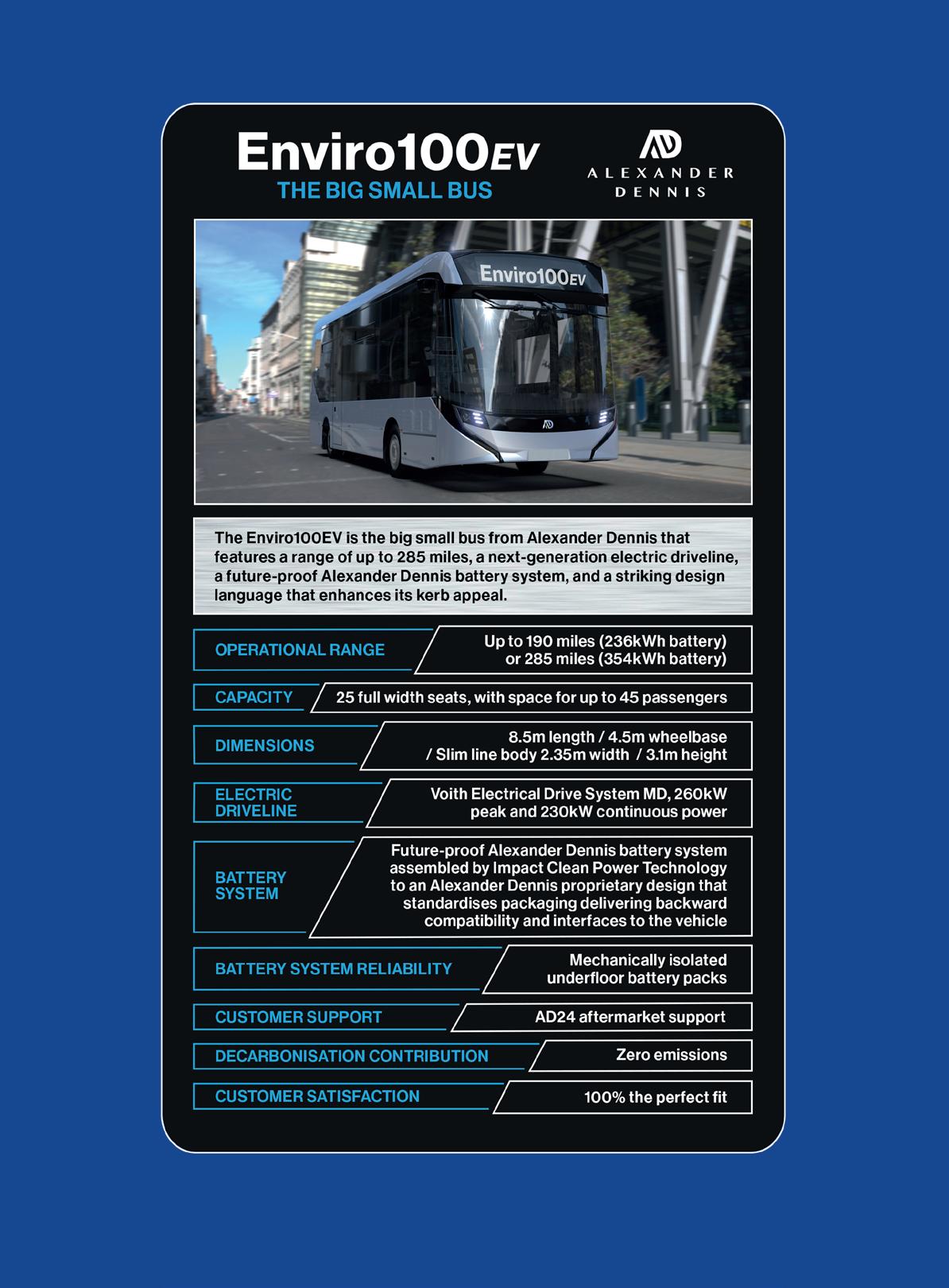

Vehicle purchasing
Crown Commercial Service’s (CCS) Purchase of Standard and Specialist Vehicles framework enables central government and the wider public sector to buy standard, converted and specialist vehicles

Agreement RM6244 is running from 29 November 2022 to 28 November 2026, with 10 lots and 77 suppliers.
Scope
The framework offers access to vehicles of all fuel types including electric, hybrid and hydrogen and a complete range of vehicle sizes and types including cars, vans and 4x4s. Light, medium and heavy commercial vehicles including refuse collection and waste management are included, as are minibuses, buses and coaches. The framework also offers mobile trailers and mobile units for health and other sectors and blue light emergency vehicles of all types (such as operational cars, police carrier units, dog vans, command and control units and lightweight fire fighting vehicles).
Specialist bespoke vehicles are also available, as are conversion services including specification design, body build, testing and associated maintenance.
Lots
The agreement is spread across 10 different lots and includes 77 suppliers. Lot 1: Purchase of Passenger Cars (including 4x4 variants) enables buyers to purchase cars including saloon, hatchback, estate, coupe, convertible, sports utility vehicles, 4x4s and multi-purpose vehicles.
Lot 2: Purchase of Light and Medium
Commercial Vehicles up to 7.5T covers the purchase of light and medium commercial vehicles up to 7.5 tonnes and provides a range of commercial vehicle types including: vans; E
Framework RM6244 Issue 30.3 | GOVERNMENT BUSINESS MAGAZINE 83
F chassis cab; combi; crew; panel; tippers; dropside; fridge vans; fridge box; platform cab; and car-derived vans and pickups.
Lot 3 covers the purchase of Medium to Heavy Commercial Vehicles including Chassis and Cabs. Lot 4 includes the purchase of emergency vehicles for blue light services including passenger cars, all-terrain vehicles, motorcycles, scooters and quad bikes, with Lot 5 covering Bluelight Light and Medium Commercial Vehicles up to 7.5T for Emergency Services – this includes emergency vehicles such as vans, car derived vans and pickups.
Lot 6 enables the purchase of refuse collection and waste management vehicles including rear loaders, side loaders and front loaders.
Lot 7 covers minibuses (9 - 17 seats), including accessible and patient transport and Lot 8 is for buses and coaches with more than 17 seats.
Lot 9 is for the purchase of trailers and mobile units, including health screening, events and mobile office.
The final lot is the conversion of bespoke and specialist vehicles and enables the purchase of bespoke and specialist vehicles within the following types/categories: M1 vehicles (Passenger cars); N1 vehicles: (Light goods vehicles up to 3.5 tonnes); N2 vehicles (used for the carriage of goods, from 3.5 tonnes to


Framework RM6244 84
Lot 3 covers the purchase of Medium to Heavy Commercial Vehicles including Chassis and Cabs
12 tonnes); N3 vehicles (used for the carriage of goods, 12 tonnes and above); ambulances, including accident and emergency double crew and other stretcher bearing vehicles; bluelight conversions; and other services such as: design, consultancy, livery, electrical, communications, welfare vehicles, heating, cooling, ventilation, utilities and drainage.
Buying
Purchasing through the framework is possible through direct award or further competition. Direct award works differently depending on the lot. For Lots 1 and 2, buyers can use the Fleet Portal to compare vehicle specifications and indicative pricing and then select the vehicle which is most appropriate for the organisation. Once the vehicle has been selected, buyers can then contact the chosen supplier to confirm pricing, volume and the supplier’s ordering process. Once ready to order, a direct award can be placed using order forms provided by CCS.
For the remaining lots, to buy a vehicle through direct award, buyers should: contact the relevant suppliers for pricing and technical information, compare their responses, select the vehicle which provides the best value for the organisation, contact the chosen supplier
to confirm pricing, volume and the supplier’s ordering process and then place an order. For more complex needs or a significant volume, buyers can run a further competition to decide which supplier can provide the best value. In order to run further competition, buyers need to complete further competition documents including invitation to tender, timetable for the competition and specification/ statement of requirements. Buyers need to prepare evaluation criteria and invite all identified suppliers to submit a tender in writing. A time limit should be set for submission of tenders and then supplier responses can be evaluated. An order should then be placed with the successful supplier and the other suppliers should be informed of the outcome of the competition.
Benefits
The framework offers several benefits, including access to an online vehicle quotation system (Fleet Portal) which provides technical and pricing information for cars and vans and a full breakdown of costs which will allow you to easily compare vehicles and the use of an average market rate comparator – CCS discounts are approximately 8.1 per cent better than those achieved by the leasing market (at the time of the Agreement going live).
The framework provides a direct award option to make use of the simple order form to simplify the procurement process. Also on offer are separate lots for both standard and specialist vehicles; dedicated blue light lots; and the option to use a local dealership for delivery and after sales service which supports SMEs. Finally, the framework offers carbon reduction and social value including access to all fuel types including zero and low emissions vehicles. All suppliers have committed to signing up to the National Highways’ Driving for Better Business scheme and all suppliers are developing carbon reduction plans working towards net zero by 2050. L
https://www.crowncommercial.gov.uk/ agreements/RM6244

FURTHER INFORMATION Framework RM6244 Issue 30.3 | GOVERNMENT BUSINESS MAGAZINE 85



secmair.fayat.com/fr
The road to net zero
In January, the government announced £30 million to fund innovative projects to decarbonise roads

Seven projects across the country have been awarded funding through the Live Labs 2: Decarbonising Local Roads competition. The programme supports projects led by local highways authorities that are focused on tackling the long-term decarbonisation of highways infrastructure.
There are many ways in which to decarbonise the UK’s roads, including using renewable electricity in construction and maintenance, planting trees and greening the roads and switching lights to LEDs.
Live Labs 2 follows on from Live Labs 1, which focused on adoption of digital technology across the local roads sector in England.
Live Labs 2 is funded by the Department of Transport (DfT) and organised by The
Association of Directors of Environment, Economy, Planning & Transport (ADEPT). Mark Kemp, president of ADEPT, said: “Tackling the carbon impact of our highways’ infrastructure is critical to our path to net zero but hard to address, so I am pleased that bidding was so competitive. Live Labs 2 has a huge ambition – to fundamentally change how we embed decarbonisation into our decisionmaking and to share our learning with the wider sector to enable behaviour change. Each project will bring local authority led innovation and a collaborative approach to create a longlasting transformation of business as usual. I am looking forward to the opportunity to learn from our successful bidders and taking that into my own organisation.”
E
Road maintenance
Issue 30.3 | GOVERNMENT BUSINESS MAGAZINE 87
Milestone Infrastructure, a part of M Group Services’ Transport Division, is the UK’s largest highways maintenance provider, designing, constructing and maintaining over 51,000km of critical highways infrastructure.

This includes 300,000 street lighting assets and complex civils infrastructure projects for public and private sectors.

First choice for clients
Issue 30.3 | GOVERNMENT BUSINESS MAGAZINE 88 https://www.milestoneinfra.co.uk Highways Safer, Greener
Safety People Delivery Integrity Inspired Teams Exceptional Delivery Strategic Growth
F Themes
The winning projects will be working together across four interconnected themes. The first theme is a green carbon laboratory which will examinine the role that non-operational highways ‘green’ assets can play in providing
a source of materials and fuels to decarbonise highway operations. This could mean, for example, using biomass from green waste to create alternative fuels and asphalt additives.

The second theme is a future lighting testbed. This involves researching the future of lighting for local roads to establish what will be needed in the future and how roads can be further decarbonised.
A UK centre of excellence for materials is the third theme. This will provide a centralised hub for research and innovation that will help test construction materials and their use.
The final theme is corridor and place-based decarbonisation, which involves working to create decarbonisation across specific, wider regions and corridors covering both urban and rural areas.
Technology and Innovation
On announcement of the award, roads minister Richard Holden said: “The UK is a world leader in technology and innovation and we must use that strength to drive decarbonisation and the next generation of high tech jobs that go alongside it.
“We are supporting this vital agenda to help level-up through £30 million funding for ground-breaking projects and boosting regional connections to support growth. E

The final theme is corridor and place-based decarbonisation, which involves working to create decarbonisation
Road maintenance Issue 30.3 | GOVERNMENT BUSINESS MAGAZINE 89
F “The government is determined to create good, well paid jobs – via innovation and investment across the UK – as we accelerate the road to net zero.”
The seven winning local highways authorities, along with their partners will be given funding to develop, test, pilot and roll out new technologies to facilitate decarbonisation, including in supply chain emissions.
Winners
The winning projects include cutting carbon emissions from streetlights to producing asphalt made from green waste like grass cuttings. UK Centre of Excellence for Material Decarbonisation in Local Roads, North Lanarkshire Council will create a centre developing a materials testing programme, which

will identify and deploy the latest tech for road construction. It will also test and deploy recycled materials from other industries to build roads.
Decarbonising street lighting, East Riding of Yorkshire Council – the council will work on increasing efficiency for low-carbon lighting to ensure they can still be seen clearly by drivers. They will also create a framework for an alternative manual for highway lighting, signing and road marking.
Highways CO2llaboration Centre for materials decarbonisation, Transport for West Midlands will support upskilling and developing a team in the West Midlands to decarbonise highways with two initiatives. There will be a ‘Highways CO2llaboration Centre’, as well as demonstrator sites which will showcase and monitor innovative decarbonised highway materials.
A382 Carbon Negative Project, Devon County Council. The council intends to drive changes to the design, construction and maintenance of typical aspects of highway construction in order to reduce carbon emissions. A new link road will also be built which will include walking and cycling options.
Net Zero Corridors, Wessex Partnership. The Partnership in Somerset, Cornwall, and Hampshire will pioneer net-zero roads that are built without creating more carbon emissions overall in nine ‘net zero corridors’ linking rural and urban areas.

Road maintenance 90
Ecosystem of Things, Liverpool City Council. The council aims to introduce an ‘Ecosystem of Things’, which will explore a scalable and transferrable approach to understanding various systems. This includes design, public spaces, materials/process technology, recycling infrastructure and the legal, contractual and procurement processes. This will be carried out at city level to embed and adopt decarbonisation initiatives.
Finally, a net carbon-negative model for green infrastructure management at South Gloucestershire Council and West Sussex County Council aims to develop a first-of-itskind approach to creating a net carbon negative model for building and delivering green infrastructure. This could include for example recycling biomass from green waste. L
https://www.gov.uk/government/news/30million-government-funding-for-innovativeprojects-to-decarbonise-uk-highways

Quality Line Marking Paints

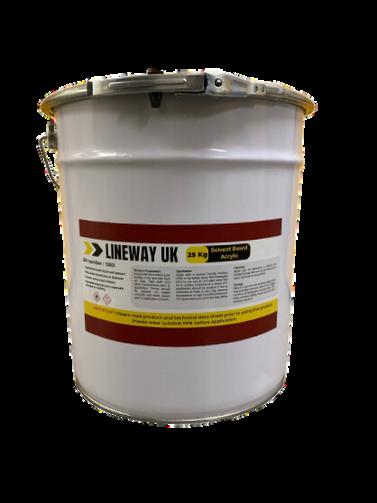
We supply quality cold line markings at very competitive prices



Advantages of cold paints; Lower costs - machinery, permits, training and insurance
Low risk of injury compared to hot thermoplastic
Better for environmentless carbon footprint

Some of our popular products include Solvent Based Acrylic, MMA hand applied, MMA Spray and Single Pack Epoxy

sales@linewayuk.com
0330 133 4134 www.linewayuk.com

INFORMATION Road maintenance Issue 30.3 | GOVERNMENT BUSINESS MAGAZINE 91
A net carbon-negative model for green infrastructure management at South Gloucestershire Council and West Sussex County Council aims to develop a first-ofits-kind approach
FURTHER
100% ELECTRIC ZERO EMISSIONS NO RESTRICTIONS

The Goupil G4 is ideally suited to improve access into low emission zones, cities and town centres. With 11 different body configurations there is a Goupil to suit a number of applications.


GOUPIL ELECTRIC LIGHT COMMERCIAL ROAD VEHICLES WWW.BRADSHAWEV.COM/GOUPIL-ROAD-VEHICLES ENQUIRIES@BRADSHAWEV.COM 01780 782 621
Zero waste to landfill
What is zero waste to landfill and how can it be achieved?
Simply put “zero waste to landfill” means reducing the amount of waste that ends up in landfill.
Avoiding landfill
It goes without saying that landfill is not a desirable waste disposal solution, however it is not always easy to achieve this.
We know that landfill is bad, but why? Landfill is a piece of land that is used to dump waste, but that waste will essentially stay there forever, and we can’t keep filling it up.

Landfill produces foul smells, which are not pleasant for those nearby. However, the decomposing of the waste can also produce highly flammable gases, such as methane, which creates a dangerous situation.
Landfill is also a large producer of greenhouse gases and therefore, a large contributor to global warming and the climate crisis.
We already mentioned that the waste in landfill isn’t going anywhere. We know that a lot of materials that are disposed of in landfill, such as plastics and glass take a very long time to decompose (and we also know that this waste can be recycled!). However, food waste that gets caught up in landfill also takes longer to decompose, because it does not have access to enough oxygen.
Waste in landfill also produces leachate, a liquid that runs through waste – think bin juice on a massive scale. This leachate ends up in
the environment, gets into water supplies and threatens the local environment.
Call to action
However, there are ways to avoid sending waste to landfill, and it really begins with a PSA to your residents.
Recycling – though most people do this without thinking, there is still more that can be done. Encourage your locals to separate and clean their waste appropriately. Provide recycling bins in the town centre, at parks and on busy walking routes. You can also work with local business, for example by encouraging coffee shops to only supply recyclable, reusable or biodegradable coffee cups.
Reusing or donating – Encourage locals to reuse their waste: cardboard boxes, jars and shredded paper can be used for storage. A plastic bag can be used many times! All of these can also be used for children’s craft activities without having to spend any extra money. Electrical waste and clothes can often be repaired before being thrown away.
If it still works and/or is in good condition, electrical waste and clothing can also definitely be donated. Charity shops and schools will often be grateful recipients of this kind of “waste”.
Waste to Energy – if all other avenues have been exhausted, waste can be taken to a wasteto-energy facility, where it is incinerated to produce electricity. E
Waste Management Issue 30.3 | GOVERNMENT BUSINESS MAGAZINE 93
Wheelie Bin Solutions — the home of top-quality, value-for-money wheelie bins and accessories for commercial and residential customers.





All our wheelie bins for sale are manufactured in Europe to a high specification, and we are proud to provide both plastic HDPE and metal wheelie bins. We strive to be the UK’s cheapest online supplier of 2 and 4 wheel wheelie bins. Whether you need a standard 240 litre council bin, or an industrial-size 1280 litre wheelie bin for your business premises, we always provide a fast, friendly service and aim to ship all bins within 3-5 working days of purchase.


We stock our two wheeled waste bin in 60 litre, 80 litre, 120 litre, 140 litre, 240 litre and 360 litre capacities.

94 BUSINESS INFORMATION FOR LOCAL AND CENTRAL GOVERNMENT | www.governmentbusiness.co.uk NEED 2 WHEELED BINS NEED 4 WHEELED BINS SHOP NOW SHOP NOW FAST DELIVERY BUY MORE,SAVE MORE! Call Now: 07931 306 605 CLICK TO EMAIL Our adaptable 4 wheeled wheelie bins are available in 660 litre, 770 litre, 1100 litre and 1280 litre capacities, and you can choose between our hard-wearing HDPE bins or our metal bins.
terrawatch.co.uk terrawatchltd@gmail.com Tel: +353 (0)56 776 8619 Mobile: +353 (0)86 822 6911 Terra Watch Ltd is one of the leading providers of Mobile Sludge Dewatering equipment in the UK Manufacturer of high quality steel skips, forklift attachments and stillages for materials handling, recycling and waste management sales@euroquip.net www.euroquip.net Call us today: 01531 820 545
F The waste hierarchy
The waste hierarchy is a model outlining the most desirable methods of waste disposal. Prevention is at the top of the model. Basically, the best way to not send waste to landfill is to not create it in the first place. This can be achieved by not printing off emails to save paper, meal planning to avoid food waste, or bring a packed lunch to work to avoid single use packaging.
The second layer of the hierarchy is preparing for reuse. As mentioned above, many things can be reused to avoid going to landfill. Perhaps you could offer a clothing collection or electric collection service with your waste collections and then offer these to local organisations in need.
Next comes recycling. Many things can be recycled, and locals should be encouraged to do more. However, they do need the facilities and services in place to be able to do this!
Recovery is next in the hierarchy; this is transforming waste into energy, as explained above.
The bottom of the hierarchy is disposal to landfill, and this is what we are aiming to avoid.

Certification
With many organisations claiming zero waste to landfill, the Carbon Trust has created a certification to provide independent verification.
“The Carbon Trust Standard for Zero Waste to Landfill recognises organisations that demonstrate leadership in waste management.”
The standard recognises organisations taking a best practice approach to waste management, and actively diverting all appropriate waste streams from landfill.

It is noted that when aiming for zero waste to landfill, “zero” does not mean absolute zero. For example, the ash that is produced after burning waste must be disposed of. Also, some hazardous materials must be sent to landfill as there is no other option.
Case Study:
Westminster City Council’s Commercial Waste Services helped the Institute for Government, after the institute had problems with its private commercial waste collector. Westminster City Council’s Commercial Waste Services provided a revised collection set up, with a more reliable, transparent and sustainable approach to waste and recycling.
The council carried out a waste audit to establish where things could improve and put together an improvement plan for the collection of general waste and recycling from the institute’s headquarters.
A simple change was increasing the number of recycling bins to match the number of general waste bins. This encourages more recycling and also gives the means to do so. The collection of recycled waste was also increased to match the new bins. Following the change, the institute achieved a 37.5 per cent increase in their recycling rate.
Westminster City Council has an aim to eventually send zero waste to landfill and to process all future recycling through local facilities only. L
The best way to not send waste to landfill is to not create it in the first place
Issue 30.3 | GOVERNMENT BUSINESS MAGAZINE 95
Waste Management





































WEEERECYCLING TI MA
DATACENTRE BATTERY ITAD TRAKK-IT DIALADISA NG REMOTEDA ERASURE CERTIFIED GING E REFURBISH SUSTAINABILITY MANAGEMENTWEEERECYCLINGSECUREDATADEDATACENTRE BATTERY AD DIALADISA ERASURE EDRTIFI REDITEDREUSE SUSTAINABILITY WEEE Recycling and Scrap Disposal Secure Data Destruction Data Centre Services Mobile Refurbishment and Reuse Technical Services IT Refurbishment and Reuse ▶
SECUREDATADESTRUCTIO
What is WEEE recycling and why is it important?
Waste Electrical and Electronic Equipment recycling (WEEE) is a specialist part of the waste and recycling system

According to the Health and Safety Executive, an estimated 2 million tonnes of WEEE items are discarded by householders and companies in the UK every year.
Generally, WEEE refers to most products that have a plug or battery, electrical or electronic goods that are being thrown away. It is one of the fastest growing waste streams, with many products facing high turnover as technology improves every year and new technology is released.
There is a large amount of WEEE waste that needs to be handled appropriately to protect human health, stop environmental damage and prevent the economic value of these products being lost. Think of how many fridges, washing machines or microwaves you have owned and where they may be now.
Recycling these products is important to save natural resources, reduce carbon emissions and reduce mining for primary materials. WEEE recycling is the safe, eco-friendly disposal of Waste of Electrical and Electronic Equipment (WEEE).
Regulations
The Waste Electric and Electronic Equipment (WEEE) Regulations 2013 cover ten broad categories of WEEE. These include large household appliances (including fridges, cookers, microwaves, washing machines and dishwashers); small household appliances (including vacuum cleaners, irons, toasters and clocks); IT and telecommunications equipment (including personal computers, copying equipment, telephones and pocket calculators); and consumer equipment (including radios, E
WEEE Recycling Issue 30.3 | GOVERNMENT BUSINESS MAGAZINE 97
F televisions, hi-fi equipment, camcorders and musical instruments).
Other categories of WEEE include: lighting equipment (including straight and compact fluorescent tubes and high intensity discharge lamps); electrical and electronic tools (including drills, saws and sewing machines, electric lawnmowers); toys, leisure and sports equipment (including electric trains, games consoles and running machines) and medical devices (including non-infected dialysis machines, analysers, medical freezers and cardiology equipment).
The final two categories are monitoring and control equipment (including smoke detectors, thermostats and heating regulators) and automatic dispensers (including hot drinks dispensers and money dispensers).
According to the Health and Safety Executive, large household appliances make up over 40 per cent of WEEE.
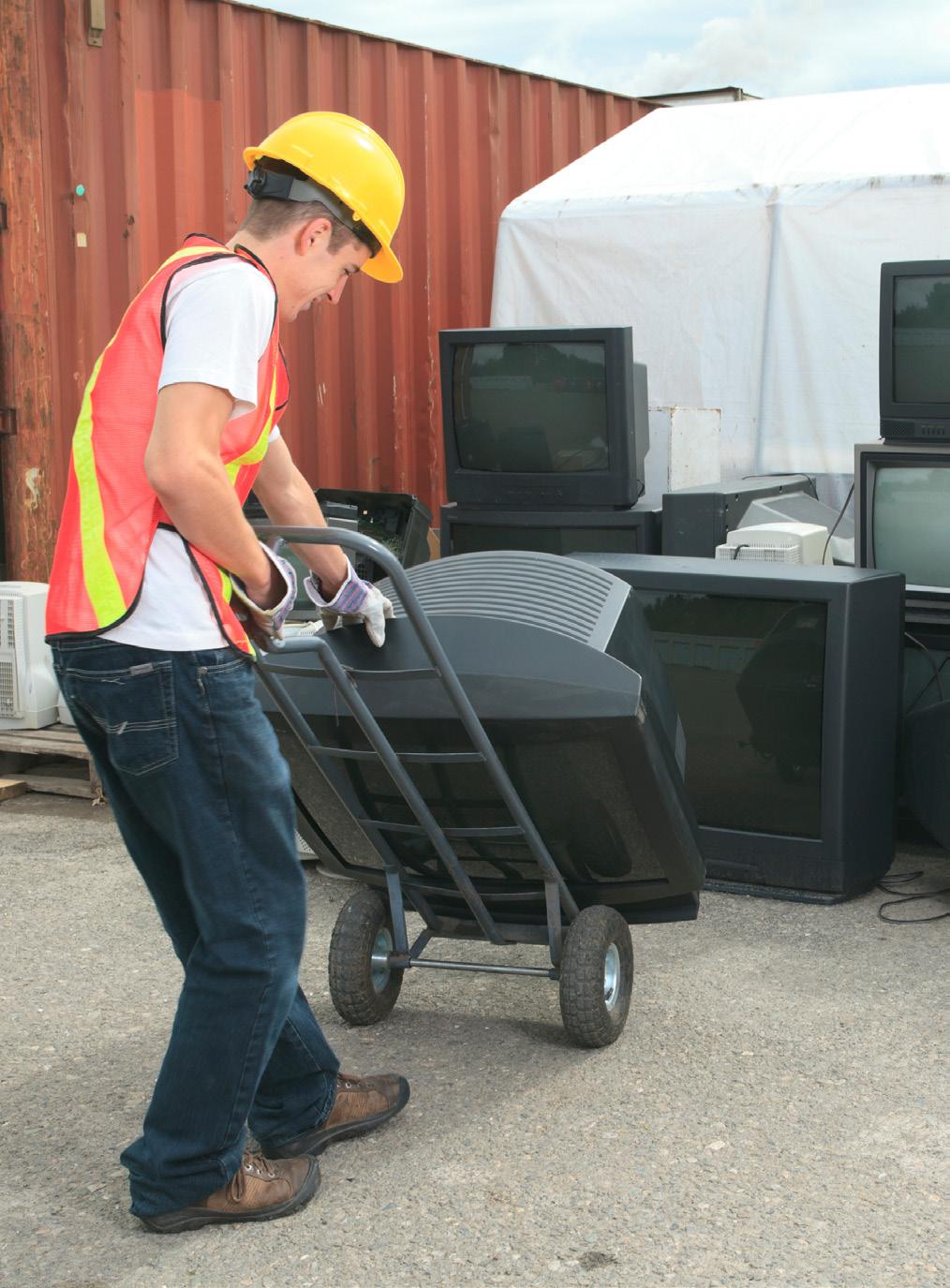
An average TV contains 6 per cent metal and 50 per cent glass, on the other hand, a cooker is 89 per cent metal and only 6 per cent glass. WEEE products contain a complex mix of product types and materials, some of which may be hazardous, so this type of waste needs to be properly managed. For example, fluorescent tubes can release mercury and lead and phosphorous pentachloride can be released from cathode ray tubes. This presents a risk to workers’ and the public’s health.
Treatment
Treatment of WEEE can vary depending on the treatment facility and the category of the WEEE itself. However, it is important that disposal follows all necessary requirements.
Certain components require different treatment, for example the fluids found in heating and cooling appliances such as fridges and freezer and oil-filled radiators. All fluids should be removed before crushing. It should be noted that older fridges may contain Ozone Depleting Substances like CFCs and HCFCs.

Parts of printers and photocopiers, like toner cartridges, liquid and paste, as well as colour toner should also be removed to prevent the dispersal of toner into the environment.
Other potentially dangerous products include
WEEE Recycling 98
asbestos, lead and radioactive substances.
If these materials are not managed appropriately, they can cause major environmental and health problems. Materials make leak, contaminate surrounding areas and kill living species.
Hazards
Besides the risks from the dangerous components of WEEE, there are other hazards to be noted.

Some machinery may be dangerous in and of itself, for example crushing, grinding, conveying, baling, compacting and palletising machines.
There is an electrical safety risk from some items, while others present fire and explosion risks.
Handling some items may present a risk of injury. Fridges and ovens, for example, can be heavy and should be handled with care and sharp items present the risk of cuts and abrasions.
On top of this, many modern electronics contain rare and expensive resources which can be recycled and reused if the waste is managed properly.



Also, many of these products contain high volumes of plastic, glass and metal which do not decompose. It should also be noted that these items take up a lot more space in landfill than other waste.
Improving the collection, treatment and recycling of electrical and electronic equipment can improve sustainable production and consumption, increase resource efficiency and contribute to the circular economy.


Councils should aim to contribute to sustainable production and consumption by preventing the creation of WEEE as a first priority, contributing to the efficient use of resources and
the retrieval of secondary raw materials through re-use, recycling and other forms of recovery and improving the environmental performance of everyone involved in the life cycle of EEE. It is important that local authorities take responsibility for WEEE recycling and provide the services for locals to dispose of this waste sustainably. L
WEEE Recycling Tel: 02081942174 Mobile: 07719159643 Website: https://erecyclinguk.com Click here to contact us via email REDUCE, REUSE, RECYCLE *FREE NATIONWIDE IT WASTE COLLECTION *Subject to items collected Issue 30.3 | GOVERNMENT BUSINESS MAGAZINE 99
Some machinery may be dangerous in and of itself, for example crushing, grinding, conveying, baling, compacting and palletising machines



100 BUSINESS INFORMATION FOR LOCAL AND CENTRAL GOVERNMENT | www.governmentbusiness.co.uk Business Information for Local and Central Go 020 8532 0055 www.psi-media.co.uk Published by Click here for your FREE subscription and to receive the latest issue and newsletter direct to your inbox Adexon Fire & Smoke are manufacturers of premium fire and smoke curtains that come with the Adexon Guarantee: Better – Safer – Certified. They only supply products with clear, demonstrable benefits that are legally compliant with the Construction Products Regulations and, are third-party certified by a UKAS or equivalent accredited Notified Body. ADEXON FIRE & SMOKE 0151 422 9111 admin@adexon-uk.com www.adexon-uk.com Protecta ® specialises in research-backed passive fire protection products . We prioritise quality, collaborating with leading laboratories for continuous development of certified solutions that are effective and reliable. Our solutions include, fire rated sealants, fire rated mortar, coatings and paints. Protecta - developed and manufactured by Polyseam Ltd, who share our commitment to excel lence. PROTECTA 01484 421036 post.uk@polyseam.com www.protecta.co.uk www.governmentbusiness.co.uk Product Finders
The publishers accept no responsibility for errors or omissions in this free service
© 2023 Public Sector Information Limited. No part of this publication can be reproduced, stored in a retrieval system or transmitted in any form or by any other means (electronic, mechanical, photocopying, recording or otherwise) without the prior written permission of the publisher. Whilst every care has been taken to ensure the accuracy of the editorial content the publisher cannot be held responsible for errors or omissions. The views expressed are not necessarily those of the publisher. ISSN 1470-0735
Government Business is a member of the Independent Press Standards Organisation (which regulates the UK’s magazine and newspaper industry). We abide by the Editors’ Code of Practice and are committed to upholding the highest standards of journalism. If you think that we have not met those standards and want to make a complaint please contact Polly Jones or Angela Pisanu on 0208 532 0055. If we are unable to resolve your complaint, or if you would like more information about IPSO or the Editors’ Code, contact IPSO on 0300 123 2220 or visit www.ipso.co.uk
Issue 30.3 | GOVERNMENT BUSINESS MAGAZINE 101
Business Information for Local and Central Government
ADVERTISERS INDEX
Advertisers Index Adexon 100 Alexander Dennis 82 Aplus Safety and Training Services 18 Bradshaw Electric Vehicles 92 Brainsparker 22, 26 Clearsafe Knotweed 42 DB Fire Safety 26 Drainage Advisory Services and Assistance 13 E-Recycling Solutions 99 Essential Safety Products 24 Euroquip Newent 94 Geofire 24 GovNet Communications 52, 58 Grant Thornton 60 Guardian Consultancy 24 HP Supplies 34 Iizuka Software Technologies 68 Integreon Managed Solutions 76 Intuity Communications 78 Invasive Weed Management 40 Isuzu (UK) BC Japanese Knotweed Group 47 JLL EMEA 8 Lineway UK 91 Milestone Infrastructure 88 Omfax Systems 15 Panamoure Group Llp 66 Philips Monitors 6 Polyseam 100 Project Health and Safety Services 16 Property Inspect 70 Road Transport Expo 20 Streamlight 10 S.H.E Advises 18 S2S Electronics 96 S4JK (Solutions for Japanese Knotweed) 44 Secmair 86 Sellox 4 Synalogik Innovative Solutions 72 TDP 39 Terra Watch 94 Thames Barrier 56 The Eastside Rooms 56 The Jockey Club IFC, 54 TTC Global 78 Twice2much 48 Urbis Schreder 29 Viewline Reporting Software 18 Wheelie Bin Solutions 94 Zinc Digital Business Solutions 74
THE ONE STOP SHOP FOR FLEET
Tailor-made to suit your business requirements, we specialise in providing pick-ups, conversions, livery and fleet solutions all under one roof.

To find out more about how the Award-Winning Isuzu D-Max is the perfect pick-up for your fleet, visit isuzu.co.uk/fleet
DRIVEN TO DO















































































































































































































































































































































